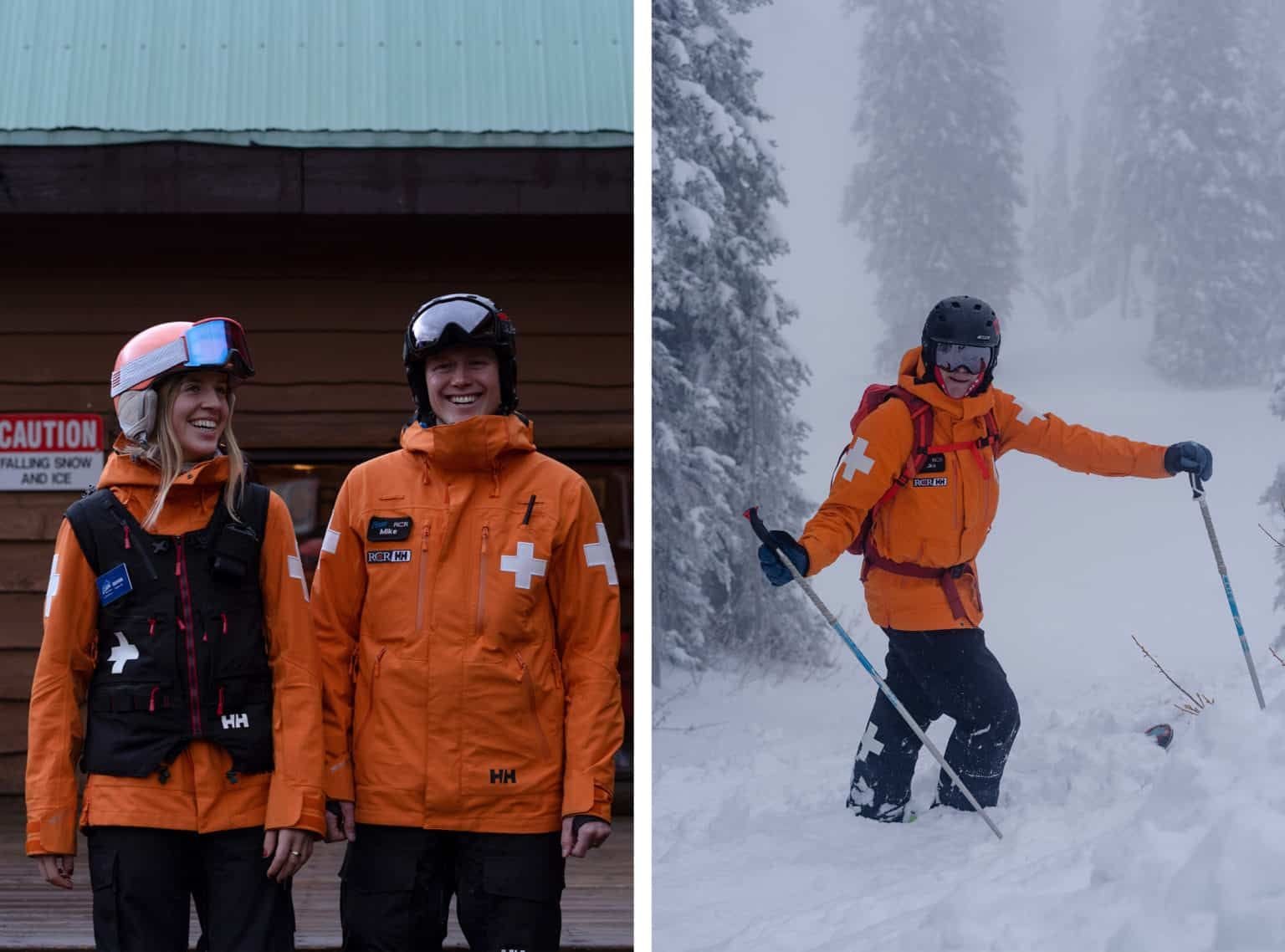The post BLACKYAK IS NEXT: The Seoul-Based Mountaineering Brand From the World’s Future City appeared first on Altitude Blog.
]]>Exiting Incheon Airport, that was my first impression of South Korea as we drove into Seoul in +35 °C weather. Dome-like mountains with rocky orange tops bordered the distance. We weaved along 5-lane highways, through thousands of Kia’s and Hyundai’s, speeding past developments along the Han River. Screens flashed advertisements. Our driver had two Samsung Galaxy’s attached to his dash. Absolutely everything was new.
Despite it being July, I was in Seoul to meet BLACKYAK – a renowned mountaineering brand designing Everest-tested outerwear. What transpired was a crash course in Korean culture during the hottest week of summer.

25 million people live in and around Seoul, a true world megacity. By the time our taxi rolled into the Gangnam district – home to the 26 neighborhoods, Samsung’s HQ, and BLACKYAK – I was overwhelmed. South Korea’s been named the most innovative country six years straight by Bloomberg. K-Wave culture has taken the globe by storm (see BTS, ‘Gangnam Style,’ and Netflix’s K-Dramas). Gangnam is the country’s cultural, tech, and business center, and trust me, the skyline shows it.
We dropped our bags in our room and jetted up to the hotel rooftop, where Seoul’s endless towers were shrouded in sunset.
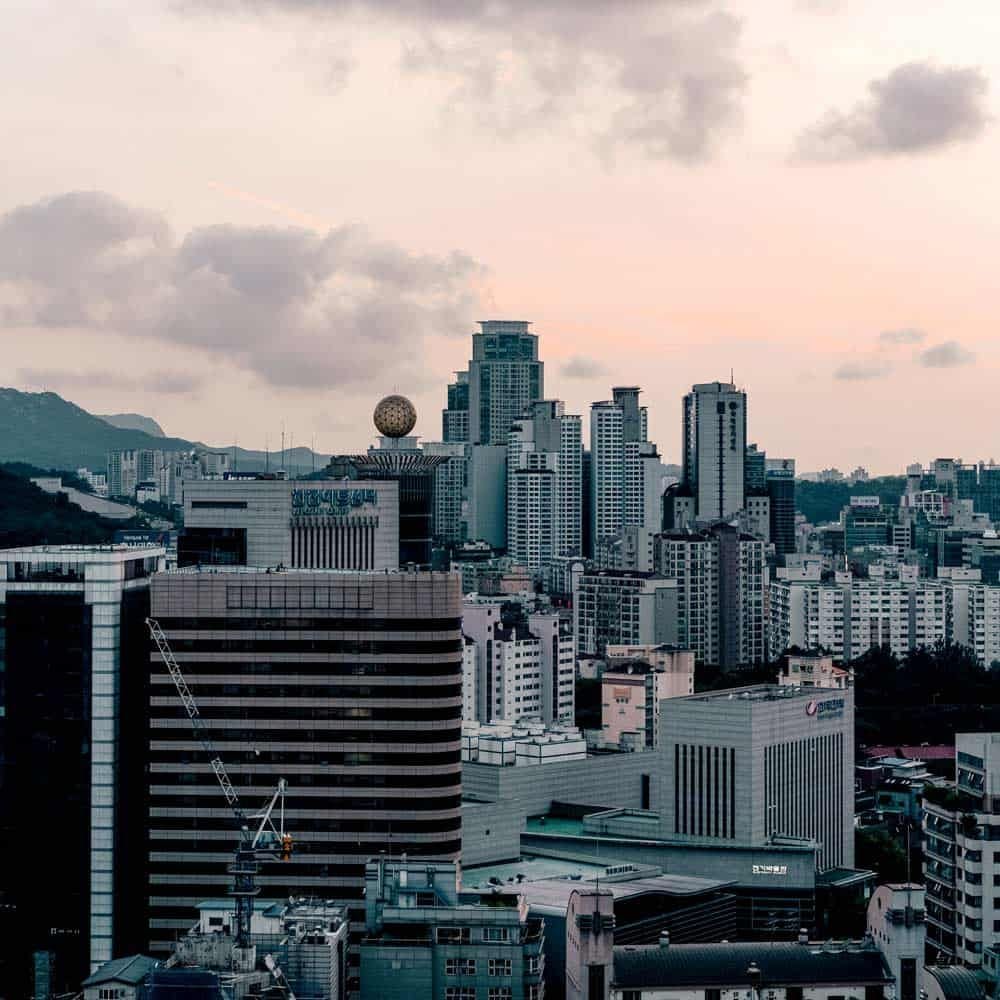
How did Seoul become the headquarters of Asia’s leading mountaineering brand? Well, Korea is 75% mountains and has a deep history of alpinism. Within Seoul, there are ranges for climbing and hiking, and nearby Pyeongchang hosted the 2018 Winter Olympics. I was told this by BLACKYAK CEO Tae Sun Kang when we met him the next morning in the brand’s headquarters, blocks from our hotel. Before that, our guide Hugh (Global Senior Manager) showed us the impressive HQ, featuring a massive storefront and trendy café.
70 and still an avid alpinist, Mr. Kang founded a mountaineering store in Seoul’s garment district in 1973. Today BLACKYAK has 300+ stores in Korea and hundreds throughout Asia. The black Himalayan yak, which Mr. Kang credits for leading him to safety when lost during a Nepalese trek many years ago, hung in artwork alongside mountaineering memorabilia throughout his office. That yak remains his inspiration.
Up close with their upcoming winter Global collection, we could see the details that have elevated BLACKYAK outerwear into the elite. Many designs use hybrid construction, incorporating up to four technical fabrics into a single jacket – almost unheard of in the weight, weatherproof, and mobility-obsessed outdoors industry. The results? BLACKYAK’s received 19 ISPO awards since they entered Western markets. Like other tech-savvy Korean businesses, their innovative products do the talking for them.
Up Birobong Peak
It was 7 AM, and I was inside a blue-lit company bus filled with the BLACKYAK Alpine Club (B.A.C.) headed to Chiaksan National Park. All BLACKYAK employees undergo mountaineering and climbing classes. After a Krispy Kreme pitstop, we arrived at the base of the 1439-meter Birobong Peak, and it was already +35 °C, my merinoblend Fulani shirt beading my sweat away.
Exiting the bus, we were handed garbage bags and pickers. The hike was part of the Clean The Mountain event – one of BLACKYAK’s initiatives to maintain alpine environments. This past spring, Mr. Kang was part of Everest’s basecamp cleanup in Nepal. Along with garment innovation, environmental preservation has become a focus of his company.
Our ascent up the shaded, sloping trail was lined with Mongolian and Japanese oaks. At a natural spring, one young trainee spotted some garbage off-trail and rushed into the bush with their picker. “There used to be more trash on the mountains. People realized they needed to be cleaned for them,” said a senior B.A.C. member, pointing to the younger recruits.
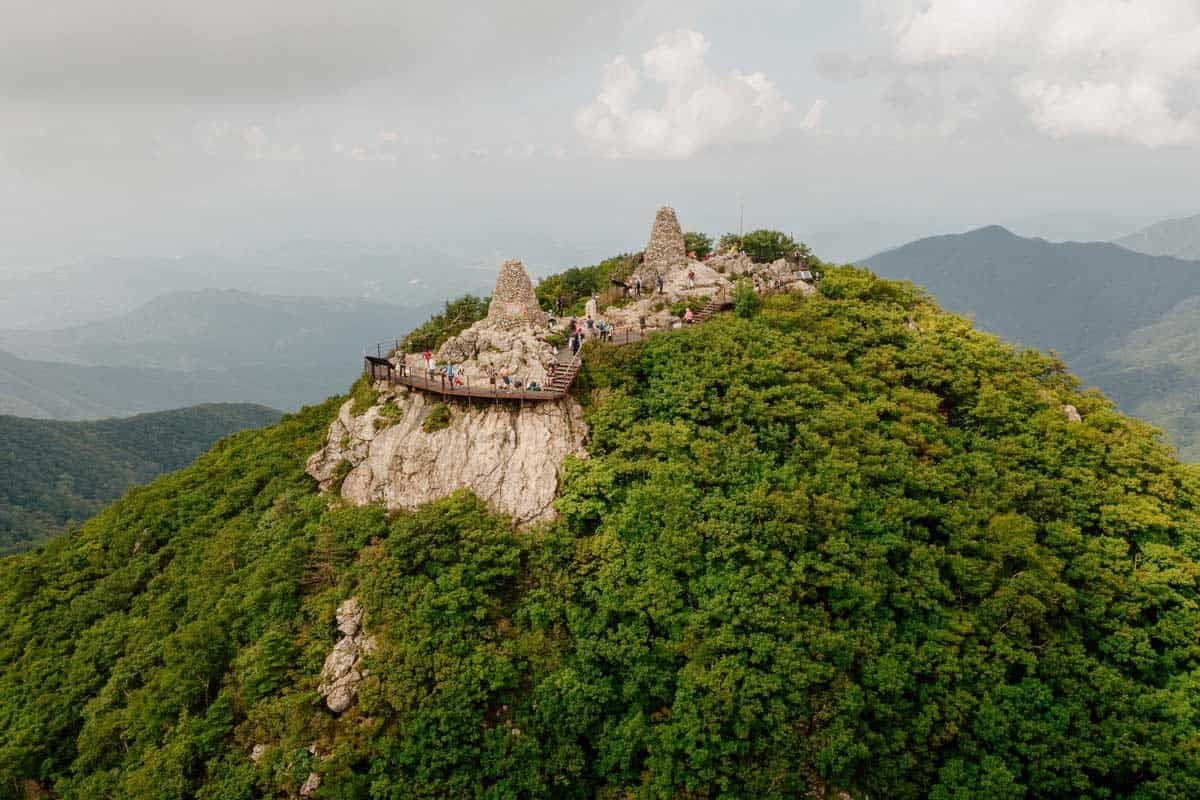
The day before, I’d met with BLACKYAK’s marketing team in a ritzy Seoul neighborhood at the NAU House café-retail hub, built with pre-assembled models to reduce its construction impact. The team explained a series of initiatives to reduce environmental degradation based on the brand tagline, ‘Made for Missions.’ They educate customers that sustainability isn’t a trend but a lifestyle, something that can be experienced (hence Clean the Mountain). Plus, the better made the gear, the less customers consume – and BLACKYAK products are renowned for quality.
The B.A.C. members on Birobong fully subscribed to this mantra, rocking gear with badges from past adventures. By the time we reached Birobong’s Peak, we were exhausted. Thousand-plus vertical meter hikes are challenging in any weather, but humidity had taken its toll. Our 40-plus member crew grabbed Kimbap (Korean sushi) and battery-powered fans from our backpacks, eating with views of the leafy valley below.
The flattened mountain base featured a fully-preserved Buddhist temple. Sore from the steep, rocky descent, soaked from a swim we’d just had at a mountain spring above, we witnessed monks leading prayer class. We drank water from a well as the temple gong rang through the valley at sunset.
Seoul – Past, Present, Future
To understand the future, you must examine the past. Much of Seoul is new after being destroyed during the Korean War. There is an understandable drive to rebuild around innovation. Korea’s geographical position between China, Japan, and South Asia is ideal for the 21st century. It allows BLACKYAK quick access to the fastest growing markets and the manufacturers that create high-end garments for the entire outdoor apparel industry.
While sightseeing, we went to the district where Mr. Kang opened his first store, and where a BLACKYAK shop still resides. It’s an area that’s still an outdoor retail hub filled with small buildings – a stark contrast from Gangnam. Next stop was the traditional Gwangjang Market, where our cabbie recommended a food stall littered with Anthony Bourdain photos amongst vendors selling dumplings, fried fish, and sauteed meats.
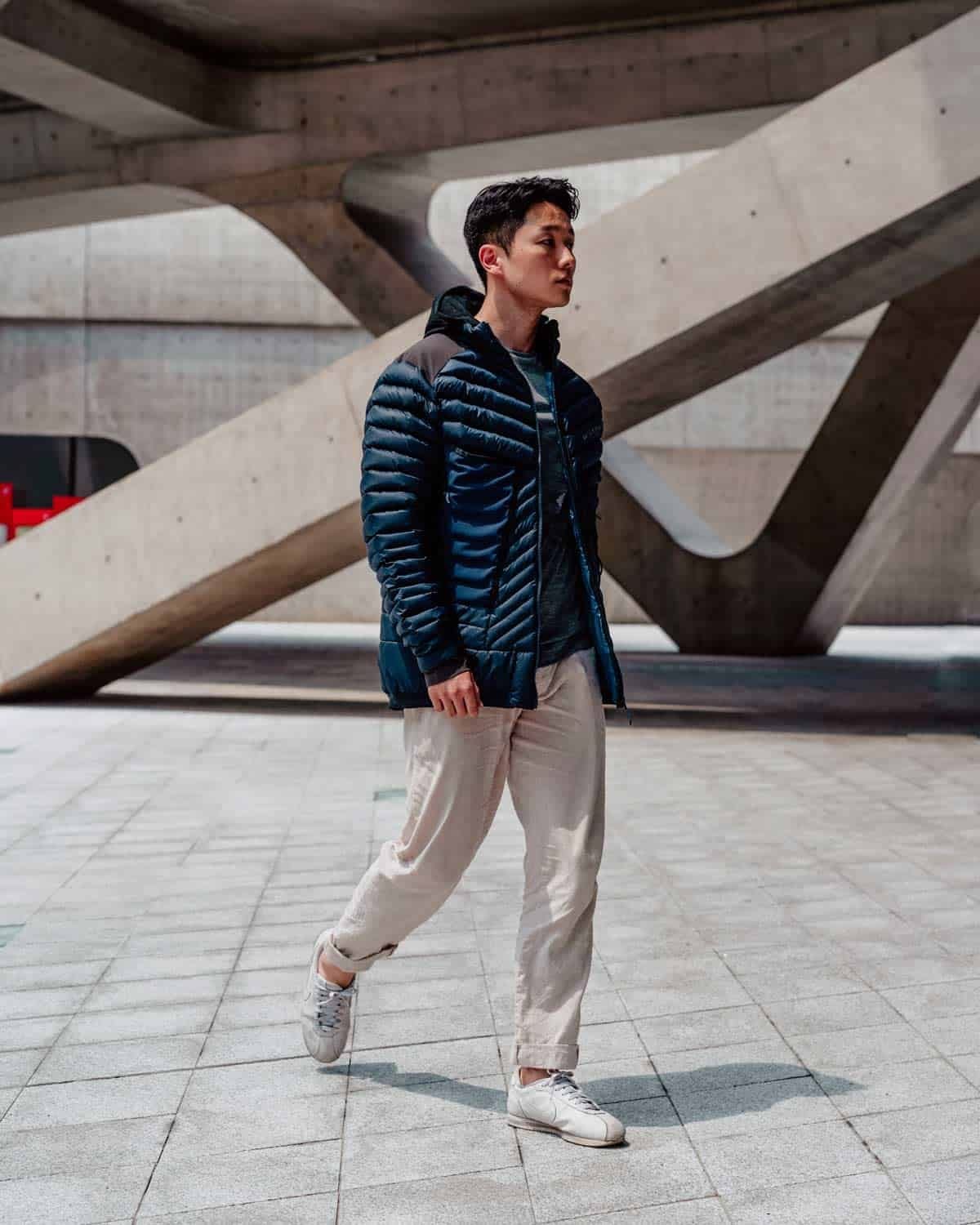
The following day, we toured the circularly-extravagant Dongdaemun Design Plaza by architect Zaha Hadid. The neo-futuristic building hosts fashion week along with cutting-edge exhibits. Its cold concrete bulges and hollowed interior were a relief from the +40 °C weather. We ended up in the 3-level d’Light exhibition at Samsung’s HQ, gesturing in front of screens while AI cleverly created narratives out of our motions.
You also can’t understand a culture without a proper meal, and in Korea, you shouldn’t eat BBQ without soju. This clear, colourless ‘burned liquor’ is a staple with crispy meat. Hugh facilitated an epic dinner at a restaurant featuring walls lined with thousands of empty soju bottles. While every imaginable cut of pork cooked on our table, we toasted new friendships and whatever else deserved a toast. We also learned the etiquette of soju bombs…turns out soju and beer mix well.
Gangnam Station on a midsummer night is neon lights and relentless energy. We stopped at bars as Korean baseball games played in window displays. Young people were out dressed in white and black, maximalist sneakers, and the latest streetwear. Noise pulsed from underground Karaoke bars and lights flashed from the 20th floor of a nearby building, showing glimpses of the nightclub within.
Reaching New Heights
Locally, BLACKYAK fosters mountaineering culture through their new B.A.C. center in the north of Seoul, near popular climbing and hiking mountains. On our final day, we visited this innovative structure, which includes a 3-story underground rock wall, a children’s gym with a five-story climbing wall, a store, plus staff and trainers. From the second-floor café window, we viewed the children’s climbing wall while parents sipped lattes nearby.
The center’s rooftop patio looks over the climbing routes pioneered by Patagonia founder Yvon Chouinard, who was stationed in Seoul post-Korean War. After touring mountaineering team guest rooms and alpine-safety course classrooms, we took turns bouldering novice rock wall routes. Our guide explained the center gives back to an area of Seoul that is a climbing mecca. Judging by children reaching the top of the walls, the future of Korean mountaineering looks bright.

For our final evening, we went up Lotte World Tower – the world’s 5th largest building – to take in Seoul’s massiveness. A ride in the world’s fastest ‘sky elevator’ shot us 118 floors in one minute. Afterwards, we spent the evening on a rooftop patio to watch the sunset behind the tower, which dwarfed the surrounding 40-story buildings. We drank beer and ate burgers as dusk settled. At dark, Lotte World Tower lit up, and a light show appeared, complete with emojis.
To say my time in Seoul was a blast of intense heat and good times would be an understatement. Exploring new cultures and settings is easier with a guide, and Hugh did a first-class job. BLACKYAK’s presence in Korea was noticeable everywhere – the brand is clearly the country’s leading technical outdoor apparel. Judging by their designs and investments, it’s only a matter of time before they follow in the footsteps of other Korean giants. Seoul is the future, and BLACKYAK is next.
The post BLACKYAK IS NEXT: The Seoul-Based Mountaineering Brand From the World’s Future City appeared first on Altitude Blog.
]]>The post Discovering the Ancient Wisdom of Sherpa Adventure Gear appeared first on Altitude Blog.
]]>The post Discovering the Ancient Wisdom of Sherpa Adventure Gear appeared first on Altitude Blog.
]]>The post Growing a Revolution appeared first on Altitude Blog.
]]>I certainly didn’t expect to find myself on a farm up to my elbows in earth, gardening with the precursors to an agricultural revolution. My impression of California was more of a place ravaged by years of withering drought and wildfires, an ironic twist to the supposed cornucopia of America.
And yet it is in precisely this climate that Patagonia is working on their new project: regenerative agriculture, an idea that has arguments that are nothing if not persuasive. Before recounting them, suffice it to say this project could change the fate of our planet.

Those Who Act—Differently
The Ventura sun beat down hot as we approached Patagonia’s seaside headquarters.
Responsibility is not a word they take lightly at Patagonia. When Yvon Chouinard founded the company in 1972, he was already on the eco-responsibility tip. Before the clothing came innovative climbing equipment that didn’t scar or damage the rock surfaces it was used on. He called it ‘Clean climbing’, the sort of foundational ethos that still drives the minds at Patagonia today.
Climate change started to become a household issue in the 90s, and Patagonia took a huge gamble by going all-in on organic cotton. By 1996 they sourced only organic cotton. “Some thought that was business-suicide,” explained Nicholas Ruiz from the Patagonia archives, “But we just couldn’t keep working with all the toxic pesticides, poisoning the environment and the people who used them.”

Clients took to the new direction. Austin McElvaney from marketing added, “We’ve always attracted a pretty conscientious clientele.” The company has tried to reduce their environmental footprint from the start, and nothing has changed.
“Organic isn’t enough.”
There is much more to do, however. “Organic was a great step forward, but it isn’t enough.” Cara Chacon, who runs the regenerative agriculture program at Patagonia, has boundless enthusiasm for the idea.
Both avant-garde and ancestral, regenerative agriculture limits working the land. It encourages the cultivation of several different kinds of crops that offer critical protective biodiversity. Cover crops add organic matter to the soil, among other benefits. These may be ancient techniques, but with deeper knowledge of how these help our ecosystem, they are more important than ever.

While organic farming eschews use of toxic pesticides, Cara pushes it further. “Regenerative agriculture lets us rebuild organic matter in the soil itself and to restore biodiversity, making farmland healthier and providing greater yield. What’s more, regenerated earth can sequester vital amounts of carbon.” Several studies on the topic suggest that regenerative agriculture might just be the best way to draw Co2 out of the atmosphere and reverse global warming.

“Our certification project, in partnership with the Regenerative Organic Certification, goes a lot further than just being organic. It stands on three pillars: soil health, animal welfare and social fairness for farmers. It goes much further than just being organic,” explained Cara.
She tells me that this is the new focus of Patagonia, with encouraging results already seen in pilot projects in the US and India. For Cara, this is the future solution humanity has been looking for.
Encouraging Results
We left Ventura and travelled to Ojai, 20 kilometers north, a small town nestled inside low-lying mountains and that feels timelessly serene. Here we found the Steel Acres farm, a Patagonia partner that cultivates fruit and vegetables using regenerative agriculture methods. And Steel Acres was where I’d get to see Regenerative Agriculture at work.
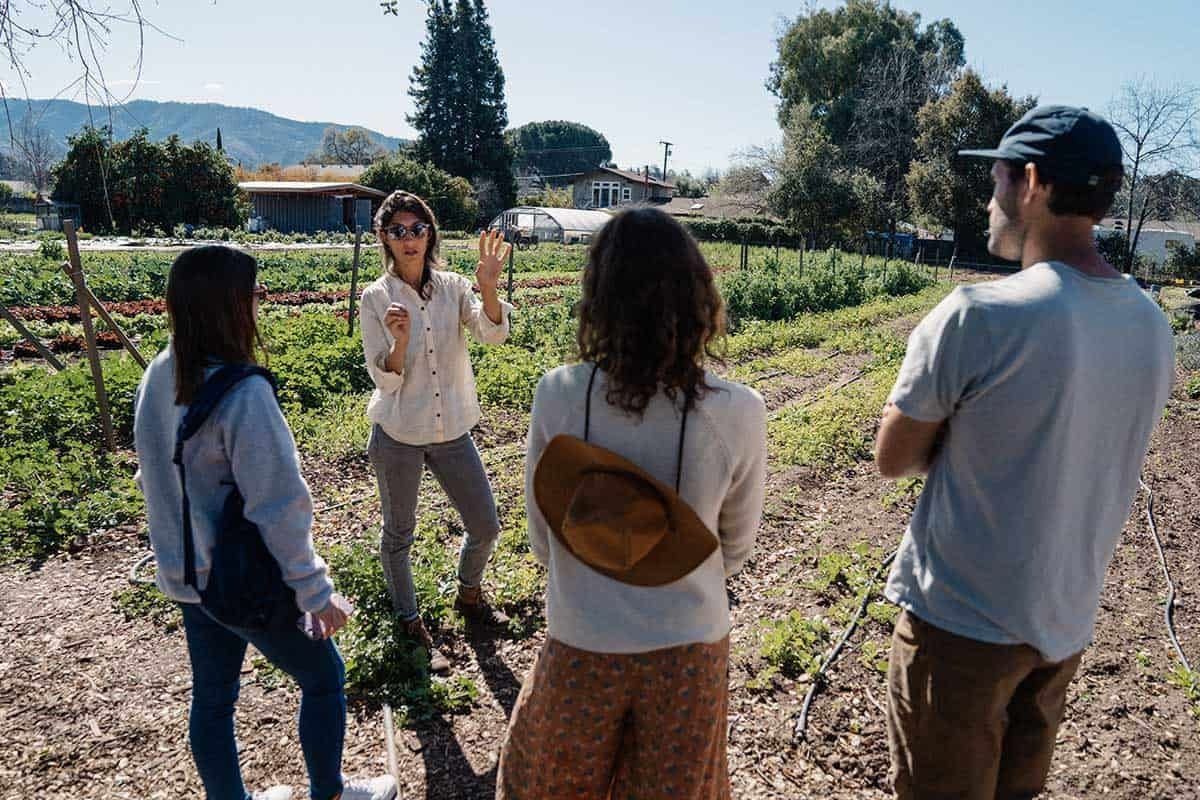
Emily Staalberg, owner and operator, sports a winning smile and dirt-caked hands. She explained that in three years her farm has boosted the organic matter in the soil by 2%—a huge difference-maker in the world of agriculture. Whether cotton or food crops, results come in fast in terms of soil health and yield when regenerative agriculture is applied.
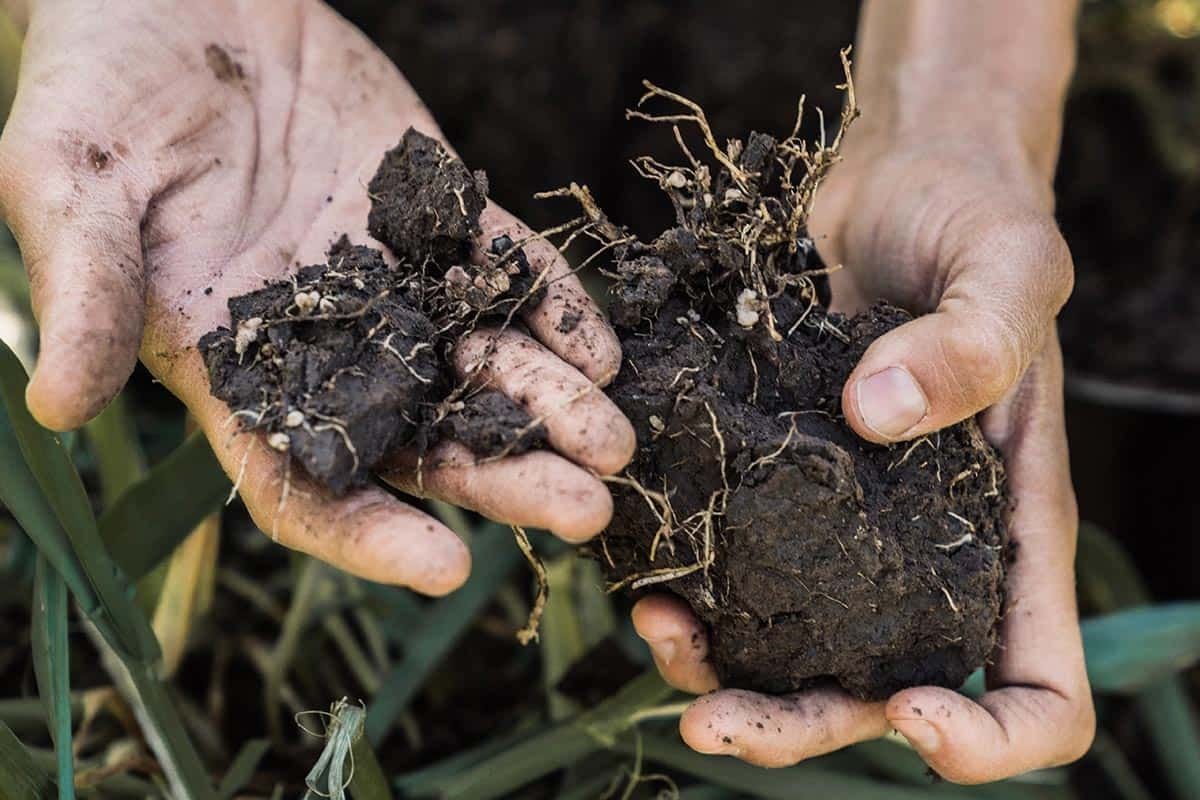
To prove the point she wins us over through our stomachs. Our wholesome lunch of lentils, vegetables, salad and fresh organic orange juice comes straight from the farm. We sit in the shade of orange trees, accompanied by rows of lettuce growing under the hot sun. “The earth is resilient,” Emily tells me. “With regenerative agriculture methods, we’ve given life back to degraded, worn-out soil.”
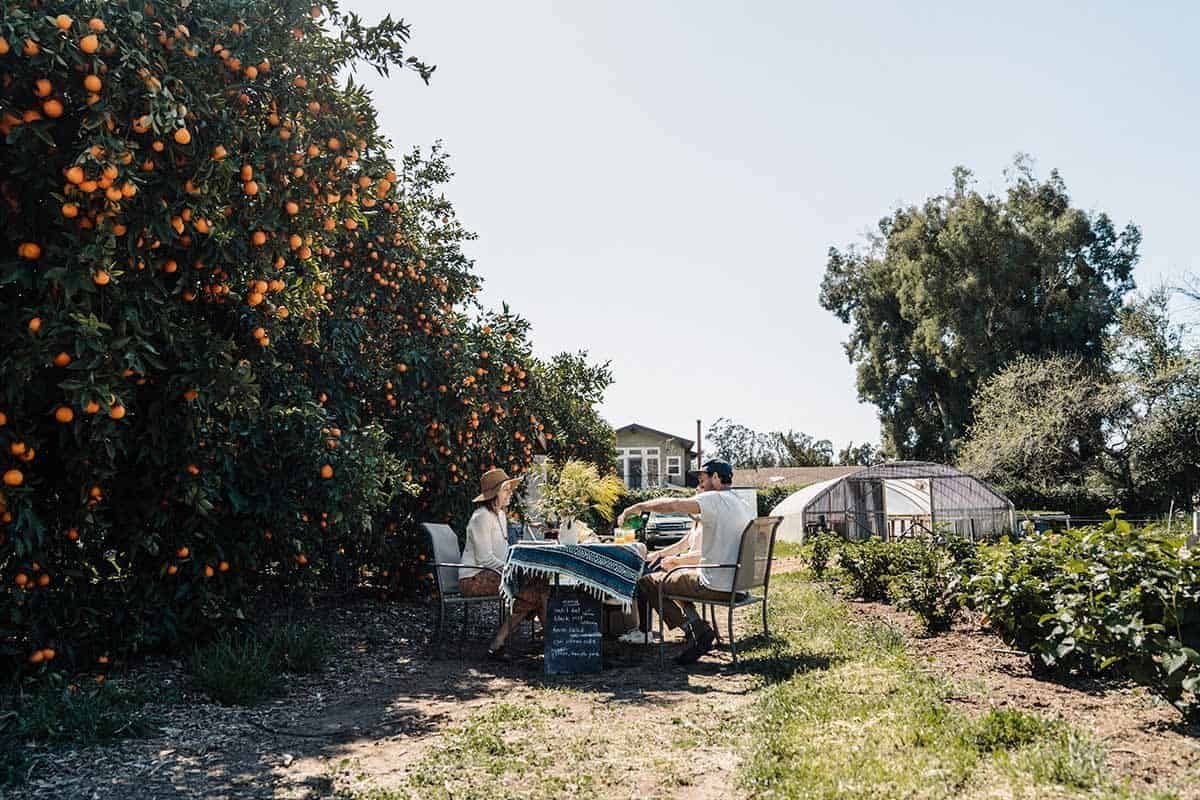
Mindset Evolution
Back at Patagonia HQ I meet Phil Graves, who runs Patagonia’s venture capital fund Tin Shed Ventures. He supervises Patagonia’s investment in third-party farms willing to try regenerative agriculture. “We’ve been using organic cotton for twenty years, but only 1% of our industry’s cotton is organic. It’s one of our biggest failures—we weren’t able to inspire or convince our peers (about organic cotton).”

Phil feels the atmosphere is different now, both literally and figuratively. Farmers have been lashed by global warming, with forest fires scorching their fields and overly-warm winters ruining their harvests. “It’s much easier now to convince farmers to get interested in regenerative agriculture,” he offers.
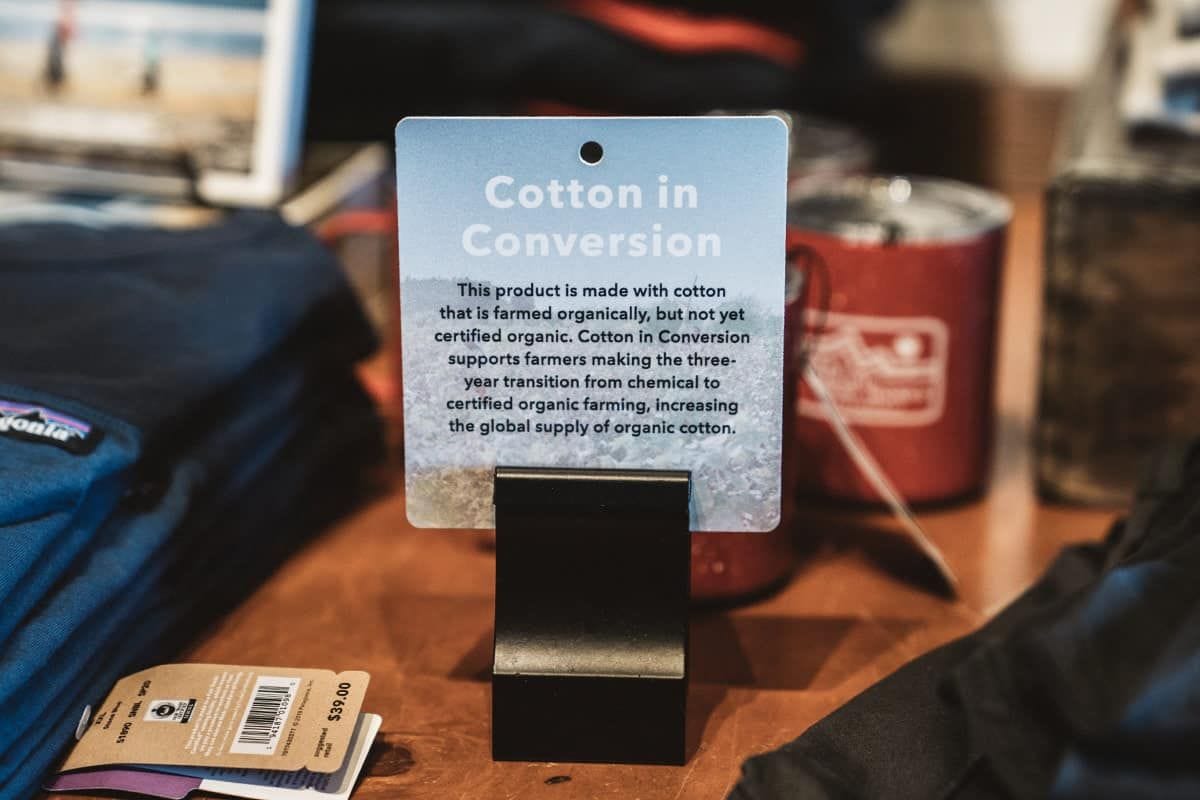
Tin Shed Ventures invests in outfits that want to try regenerative agriculture. The number of companies that have approached them already numbers in the thousands. Things are changing, and people are looking for change.
In it Together
There is an underlying irony to all this. Agriculture as we know and practice it is one of the most environmentally polluting activities humans undertake. That agriculture—albeit through a different method—also potentially holds the key to reversing that damage and global warming is quite the paradox.

Make products that last longer. Adopt a manufacturing process that is beneficial to the planet. Convince peers, competitors and consumers to follow suit and adopt or insist on regenerative agriculture. It’s ambitious to say the least. “The last thing we want to do is to go it alone,” says Matt Dwyer, talking about the ROC Certification. In charge of materials and innovation at Patagonia, he represents the fresh new wave of thinking responsibly at the company. “We want to leave the world better than we found it—and in regenerative agriculture, we finally have the tool to do it with.”

Cotton In Conversion Top Women’s |

Back Step Shirt Organic Cotton Men’s |
Can we Turn Back Time?
On my last evening in California, I leave the Patagonia headquarters behind and make my way to the famed Surfer’s Point, a stretch of golden sand that fades into the distance to the left and right, nothing but the Pacific Ocean ahead. Surfers in the water seek out the perfect wave, not thinking about the fact that in the world of tomorrow, pristine nature might be only a memory.

Meeting the change-driven people on my trip has brought a breath of fresh, optimistic air to counter the barrage of man-made disaster news. It isn’t too late to save the planet. Regenerative Agriculture, though a pilot project for now, does have the potential to reverse global warming. Patagonia, with their ethos of doing things differently, understands. And will, or maybe must, convince their entire industry to follow their lead.
It isn’t too late. But the clock is ticking.
The post Growing a Revolution appeared first on Altitude Blog.
]]>The post Fighting COVID-19: Medical Garments by Quartz Co. appeared first on Altitude Blog.
]]>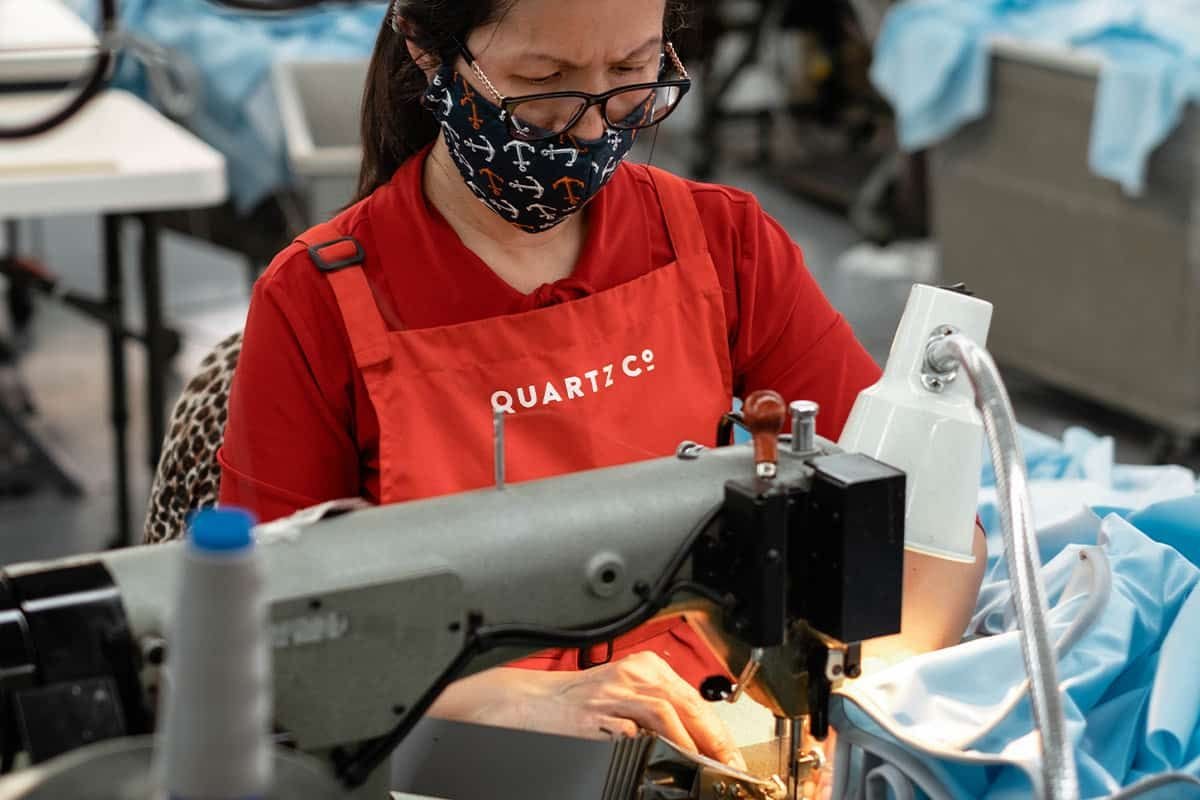
Canadians Working for Canadians
Based in Quebec, Quartz Co. operates three factories within the province: one in Montreal and one in Victoriaville. With a well-established international presence, Quartz Co. continues to manufacture its famous winter coats right here in Canada.
For Quartz Co. president Jean-Philippe Robert, it’s always been essential to develop an expertise in local production. In a crisis like the one we are experiencing today, it’s more important than ever to be able to rely on local know-how.
Read also: Our Interview with Quartz Co’s Three Brothers
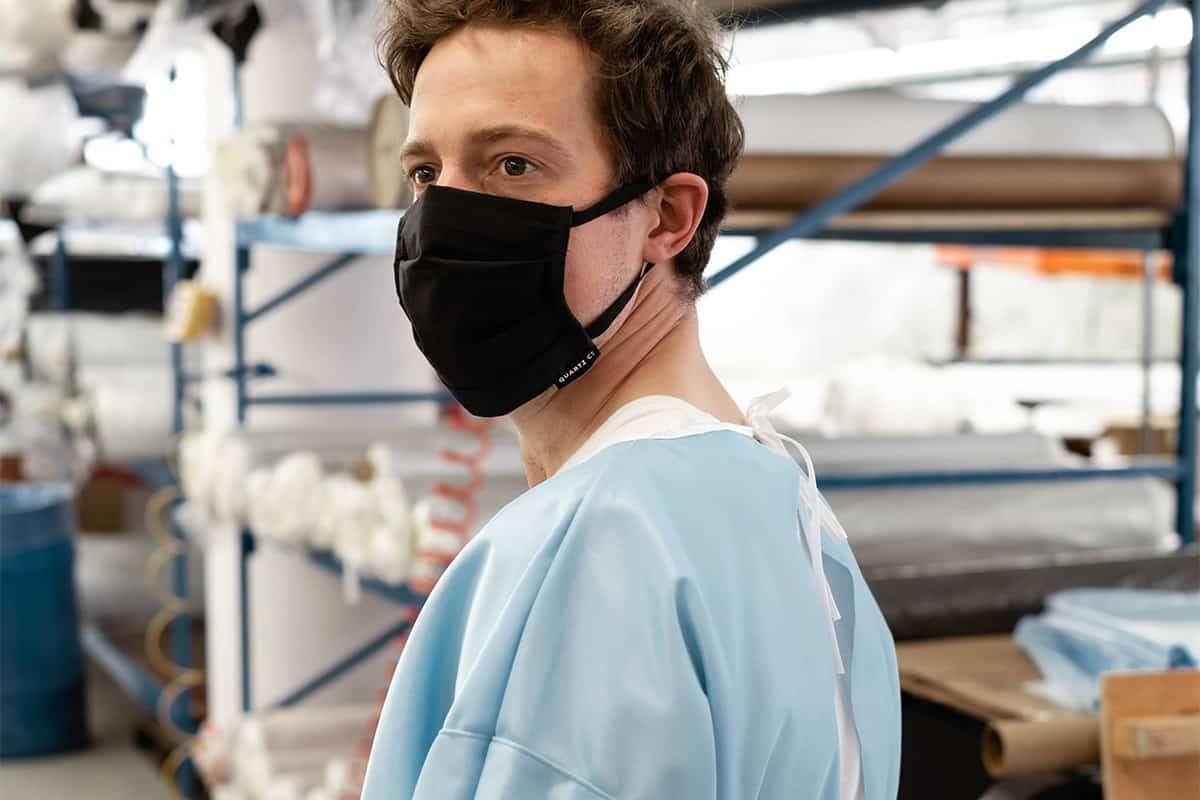
On the Front Lines: Quartz Co. Medical Garments for Health Professionals
Known for its quality winter coats, Quartz Co.’s team is now mainly dedicated to manufacturing protective medical garments.
Over 1500 isolation gowns are produced every day. These medical garments are certified and the result of many weeks of research and development. Available in different quality standards, they are all reusable and feature elastic cuffs and adjustable drawstrings.
Quartz Co. also produces medical hoods and masks, some of which will be included in their permanent clothing collection and made available to the public.
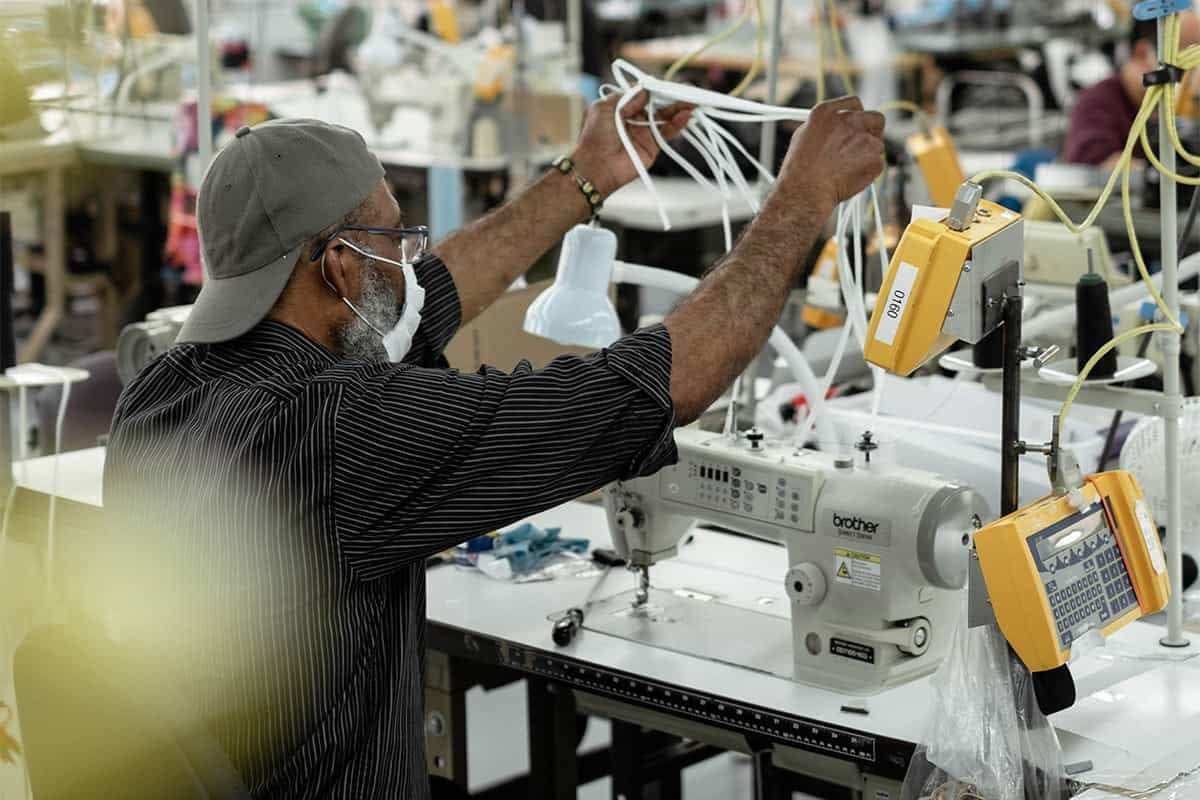
Safety First
Quartz Co. puts its employee’s safety first. Since they have reopened their factories, they follow the government’s guidelines to a tee. Workspaces are frequently cleaned and social distancing is respected.
The company is proud of how its employees stepped up to help the community. Amidst the crisis, being able to rely on certified clothes made here in Canada is a considerable asset.
For more information or to place an order, please contact: info@quartz-co.com
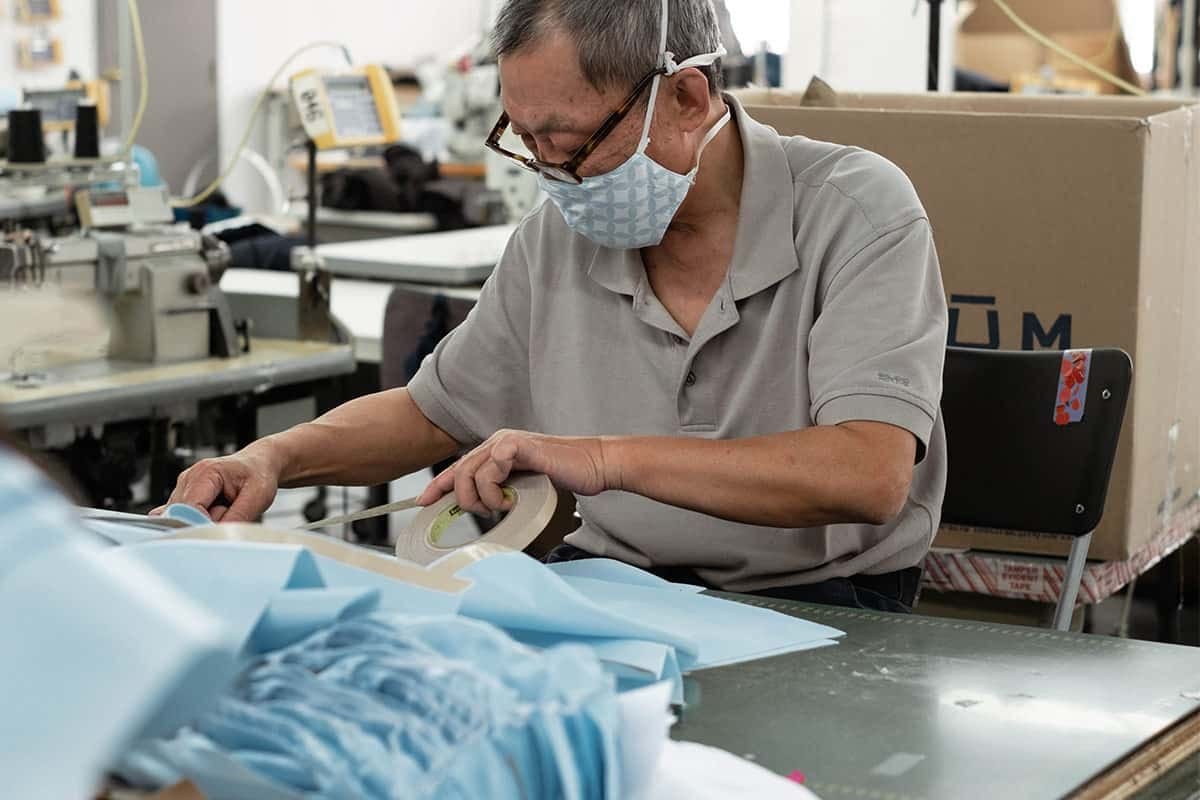
The post Fighting COVID-19: Medical Garments by Quartz Co. appeared first on Altitude Blog.
]]>The post Arc’teryx: from Outdoor Gear to Medical Gowns appeared first on Altitude Blog.
]]>The post Arc’teryx: from Outdoor Gear to Medical Gowns appeared first on Altitude Blog.
]]>The post Of Sligo: an Irishman’s Trip to the West Coast of Ireland appeared first on Altitude Blog.
]]>The west coast of Ireland has been reinvigorated in the past few years thanks to The Wild Atlantic Way. This 2,500km coastal road touches three sides of Ireland from Malin Head, Ireland’s most northern point, all along the west coast and on to Kinsale on the south coast. The Cliffs of Moher, the vibrant, musical city of Galway and the epicurean haven that is West Cork are just a taste of what this part of the world, and road, has to offer. With a population of around 19,000 people, Sligo town has a reputation beyond its size thanks to The Wild Atlantic Way and world-class surfing on the nearby beaches.
The roads cross country follow the natural hills and flow of the land. Bobbing up the climbs and tucking around the curves. The border between Ireland and Northern Ireland, a much more recent and man-made geographical feature, cuts through this part of the land. As the road dances between the two countries the only indicators of international travel are the postboxes switching from green to red, and the speed limit signs swapping kilometres per hour for miles.

The clouds hung low as I came into Sligo, so thick and heavy, I could almost reach out and touch them. It was one of those dark mornings where it seemed like the day would never wake up. The town of Sligo has been here, in one form or another, since the Bronze Age. Its name in Irish, Sligeach, directly translates to ‘shelly place’. Initially settled for its abundance of shellfish, Sligo grew into a port town. The town grew to such a size that it was even included on a map of Ireland drawn by the Greek geographer Ptolemy in 140 AD. Ever since it was first settled, Sligo and it’s people have existed alongside, and as part of, the environment.
The town is split in two by the River Garavogue, linking the centre of town with the sea. On the southern bank sits ‘Shoot The Crows’, a pure and true Irish pub. When the pub first opened under a different original name, farming was by far the dominant industry in the area. Crows were a big problem, pecking at seeds and pulling up crops. There was a bounty issued for every crow, to be paid once a week to anyone with a dead crow in hand. Being paid once a week wasn’t enough for the people of Sligo though, as it left them with no money for a pint or a whiskey during the week. The owner of the pub began to take the dead crows in lieu of payment for drinks and collected the money himself a few days later, earning the pub its name.

There are no TVs here, only the whisper of music and overflowing pockets of chats. The wooden beams of the low roof swoop and droop even further as you walk through to the back of the pub. The cold, cracked tile floor is warmed by an open fire and the windows are so small that heat can’t escape. The pub was, and still is, a much-needed shelter from the weather for the people of Sligo—this is the type of cold that makes your bones feel wet.

On the edge of town sits Benbulben. And it dominates the landscape. This otherworldly mountain starkly contrasts the flat land around it as it surges up from the ground. Its edges seem to have been sliced away, with large claw marks scarring the side of the hill. The near-vertical structure towers above the land and keeps its people living in its shadow, protecting them from the wild and the winds of the north. Benbulben holds onto clouds passing by, keeping the whole area under a blanket of protection.
As morning passes, punches of blue and brightness have battled their way through the clouds, lighting up the land below. Sheep freely graze at the base of the mountain. The only way to know who owns these sheep is to decipher the hieroglyphic-like markings spray-painted on them. Each farmer has unique markings for their animals. A red spot on the back right hip for one farmer, a blue streak down the spine for another.

Benbulben is made from the very same thing that gives Sligo its name – shells. Layers and layers of limestone made from shells have been compressed for millions of years under the sea and formed during the Ice Age. The 320 million-year-old rocks have risen up from the sea bed, becoming the mountain that now stands above and watches over its people and land. Since humans first came to the area Benbulben has played a part in Irish history. In Celtic mythology, the mountain was home to wild hunts, fierce battles and is the supposed final resting place of two Irish legends, Diarmuid and Gráinne. In more recent times, Benbulben has inspired the works of WB Yeats, one of Ireland’s greatest poets. Yeats is buried at the foot of Benbulben in Drumcliffe Churchyard, with the area being known as Yeats Country.
This hidden corner of Ireland is dominated more so by the sea than anything else. The Atlantic Ocean is a wild animal. When it’s calm it sits quietly, glistening in the sun and playfully exploring the shoreline. But when it rears its head and bucks its legs, its waves rise high above the land and, whipped by winds, it rips chunks out of the land. With each wave louder, heavier and darker than the last, it’s easy to see who, or what, is the alpha in this part of the world. Like the small remora fish that feed off and clean the shark that they’re attached to, the people of Sligo and Mullaghmore have a similar symbiotic relationship with the sea.

For hundreds of years this region of Ireland has been dotted with ports and harbours. Sailors from across Europe and Africa came here to trade. The sleepy town of Mullaghmore still has an active port with family-owned boats heading out to sea on a daily basis. Generations of experience has allowed these people to master this part of the ocean. Not everyone can successfully navigate these waters.
In September 1588 the mighty Spanish Armada attempted to invade England. After a tough battle, the Spanish tried to escape by fleeing to the waters off the west coast of Ireland. The beast was in a particularly angry mood that day and drove three of their ships into the rocky ocean floor near Mullaghmore Head, a final resting place for 1,800 Spanish sailors.

Nowadays, this part of Ireland and particularly Mullaghmore Head is known as having some of the best big-wave and cold-water surfing in the world. It takes a certain type of person to get into the water here. This is not Bali. This is not Byron Bay. This is the Atlantic. Thick, full-length wetsuits are mandatory regardless of the time of year. Hoods and boots are preferred by most as well. Before you even get into the water the wind has whipped your face, making your skin feel two inches thick. Once in the water, the cold grows through your body. Diving under, the dark green surface quickly gives way to brown and then the darkness takes over. Visibility is nearly non-existent.
The waves here are infamous. Heavy, huge and brutal. When a large swell comes through, Mullaghmore Head is only for elite surfers. With 30ft tall waves, surfing here becomes an act of survival more than anything else. As the surfer is towed in on a jetski, the wave picks them up and begins to grow, spit and barrel. This quickly encases the surfer in an icy-cold tube of emerald green and, hopefully, spits them out on the other side. Surfers need to be rescued by the jet ski as quickly as possible, or risk going the way of the Spanish Armada.

The coast shows the scars of a life alongside the Atlantic. Brittle limestone is no match for its never-ending barrage of waves. With the coastline’s cliffs and rocks eventually growing tired of the battle, they give up and succumb to the sea.
Sligo has been defined by its people’s direct reaction to the landscape. They’ve lived with it and it has become part of them, for generations and through the ages. Benbulben gives them their identity and protection. Nature and animals have shaped their way of life and culture to the environment. And the Atlantic has made them tough, resourceful, and has put this little snippet of rural Irish coast on the world map.
To keep myself dry on my trip to Sligo I wore an Arc’teryx Beta AR Jacket because of its tried-and-tested three-layer GORE-TEX Pro construction. My Patagonia Nano Puff Jacket kept me warm on cold mornings and was easily packed away when I didn’t need it.
A versatile pair of pants like The North Face Motion Pants are great on a trip like this. Durable enough for hiking and stylish enough for the pub afterwards. Blundstone 1478 Boots are great for most trips outdoors and exploring Sligo was no different.
The post Of Sligo: an Irishman’s Trip to the West Coast of Ireland appeared first on Altitude Blog.
]]>The post Kanuk—A Turn to the New appeared first on Altitude Blog.
]]>Quality, Montreal Style
Let’s dive into the reasons Kanuk had built up such a faithful fan base. First, their coats have always been made in Montreal, something that ranked high for the locals.
No matter how warm-welcoming, Montreal has always been known for glacial winter temperatures. That Kanuk was born out of this climate is hardly surprising.
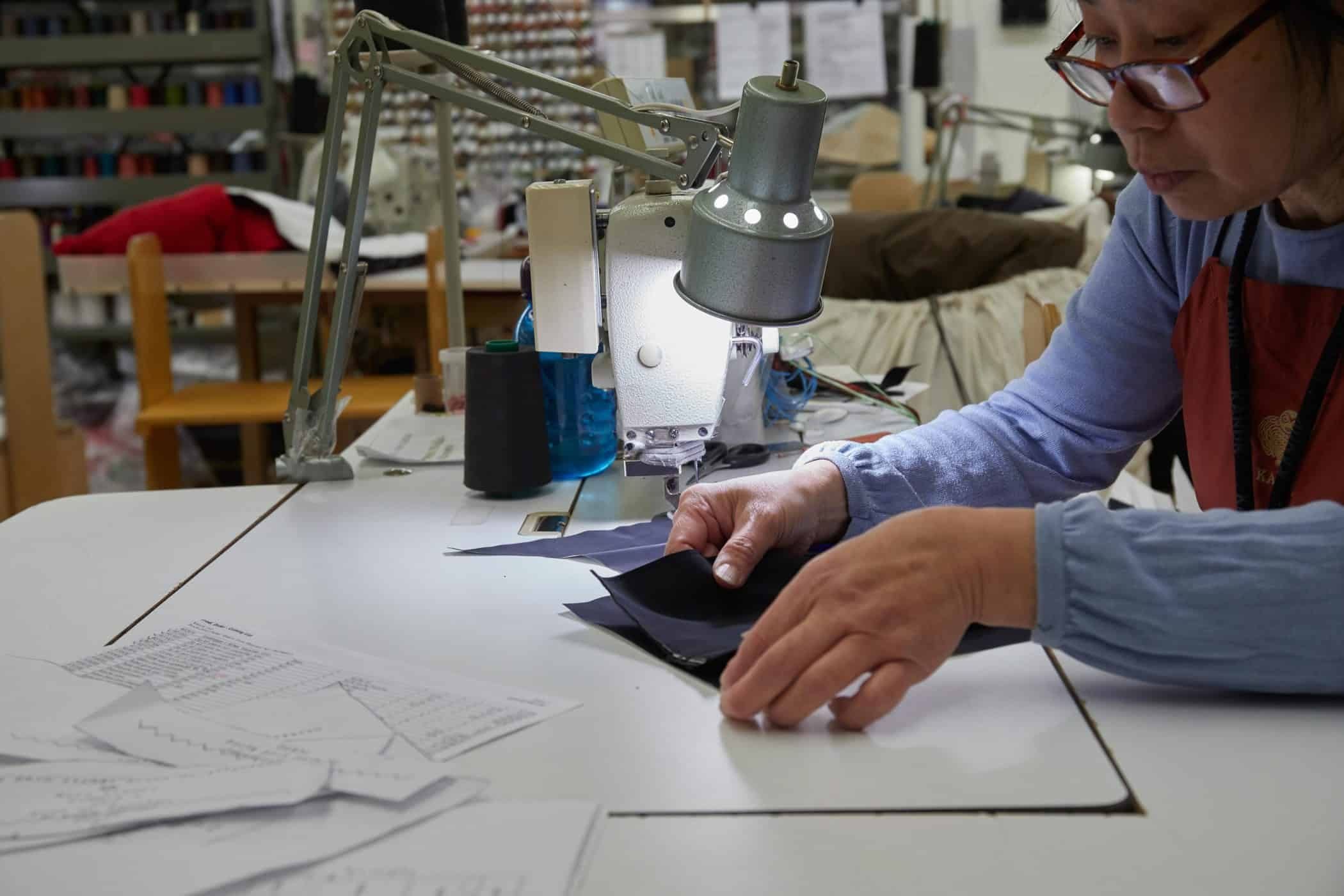
Montreal is a tourist haven that’s only getting more popular with every passing year. From well-heeled travelers to a new generation of backpackers, people have been flooding to the island metropolis for a host of cultural events, music festivals, dining, leisure and winter activities. It’s a city that absorbs a bit of everything that comes its way and updates itself constantly. If Kanuk was the winter brand par excellence of Montreal’s 70s, 80s and 90s, it too needed to modernize.
In the beginning Kanuk set out to make one thing and one thing only: warm winter jackets for Montreal winters. “In that, our clients were unanimous,” explains Michel Lepage, Creative Co-president at Kanuk, whom I met on a cold Wednesday morning at their flagship store-factory in the hip Plateau Mont-Royal neighbourhood. “The jackets were warm, insulated and with synthetic materials tailored perfectly to a humid winter climate.” You could always count on your good ol’ Kanuk jacket for warmth. Style was entirely secondary.
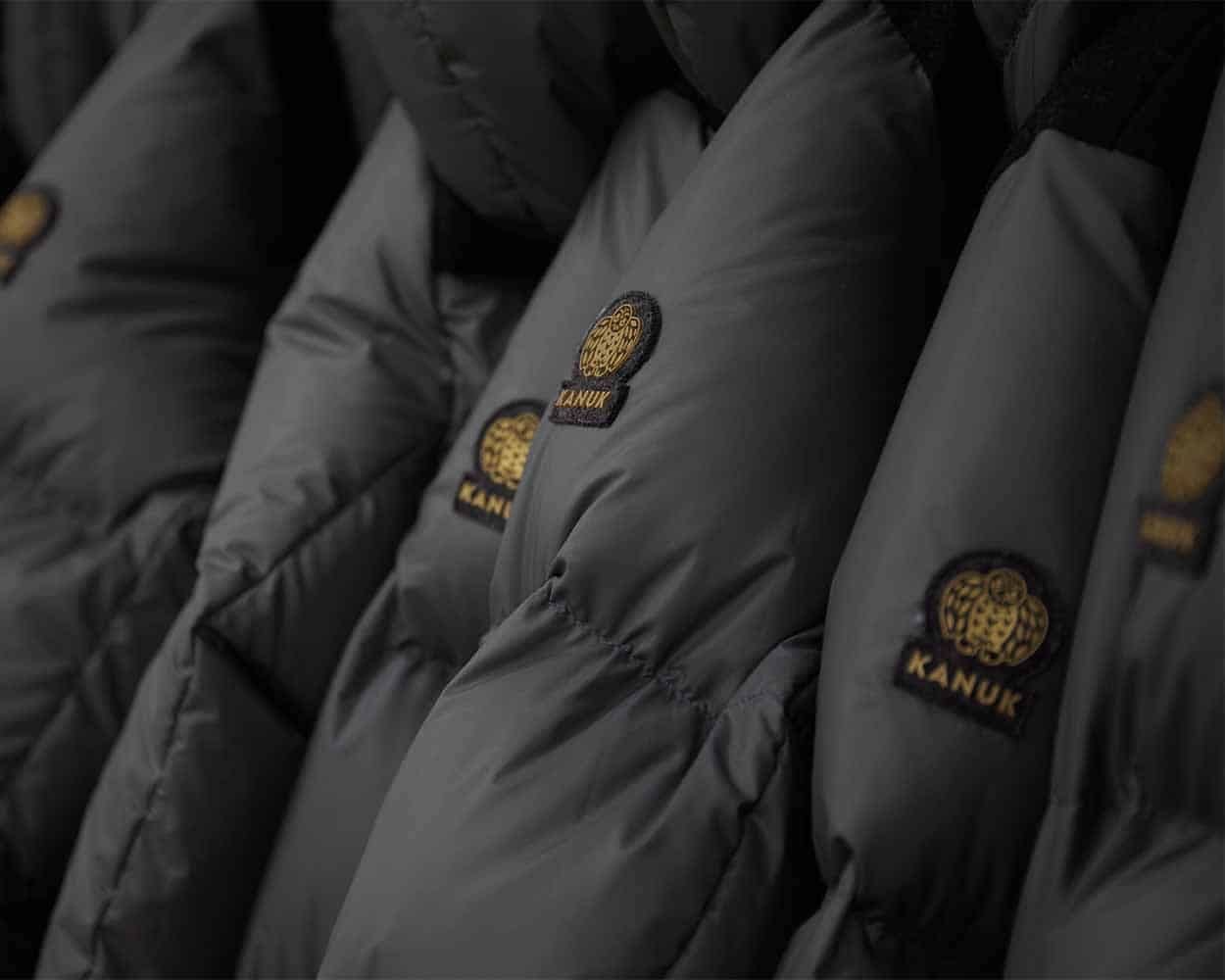
But those clients who banked hard on the technical benefits of the jackets also raised the first red flags years later. We like what you do, but the jackets feel behind the times, and the brand was in danger of becoming a relic.
Since being bought in 2015, Kanuk embarked on a modernization journey without throwing the baby out along with the bath water—being a Heritage brand has value these days. When they started looking at it closely, they saw that all their solutions were right at hand.
A U-Turn in Action
First, find the influencers—so reads the roadmap to relevance in the 2020s. Collaborating with designers like JJJJound and Instagram-friendly photo shoots atop the curiously-still-futuristic Olympic Stadium (on top of the roof, yes) appealed to a clientele a full 20 years younger. Sales prove it—the puffy Kiruna, launched in late 2018, tops the charts and is competing with the classic Mont-Royal, relatively unchanged since its first edition. “Our modern Kiruna represents our new aesthetic outlook, like a roadmap to our future,” testified designer Sara-Martine Vaillancourt. She pointed out that the use of traceable Canadian duck down signals a catering to the most on-trend—and warmest—insulator for luxury winter jackets.
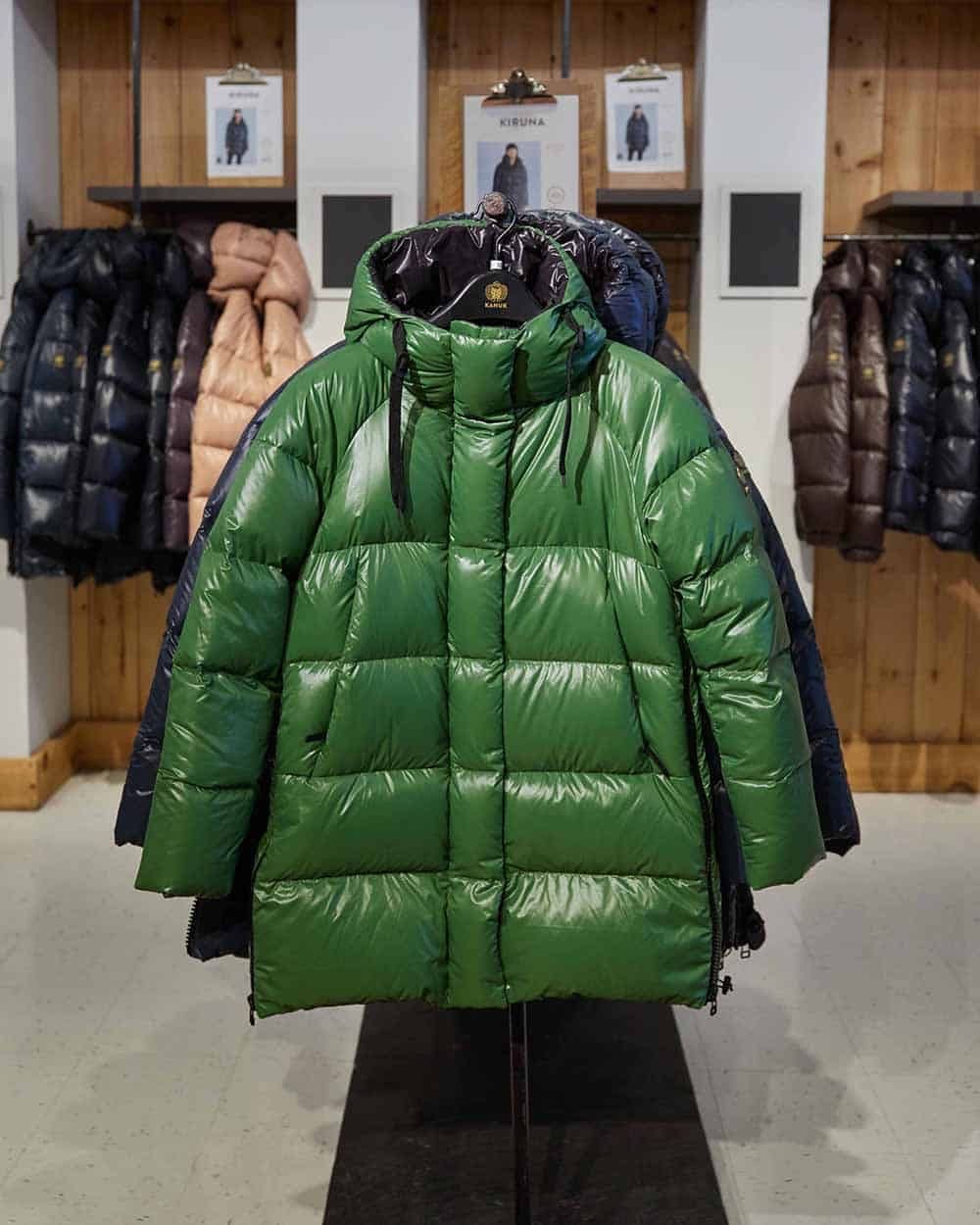
Making new-style jackets is all well and good with Michel Lepage. His dilemma was how to maintain the innovative evolution while retaining something of their heritage. “Our new line of products makes up about 10% of all our jackets, but is 90% of our customer-facing advertising,” he explained. He mixed the strongest points of their classic styles with their new aesthetic, with the end goal of making a younger clientele interested in their line.
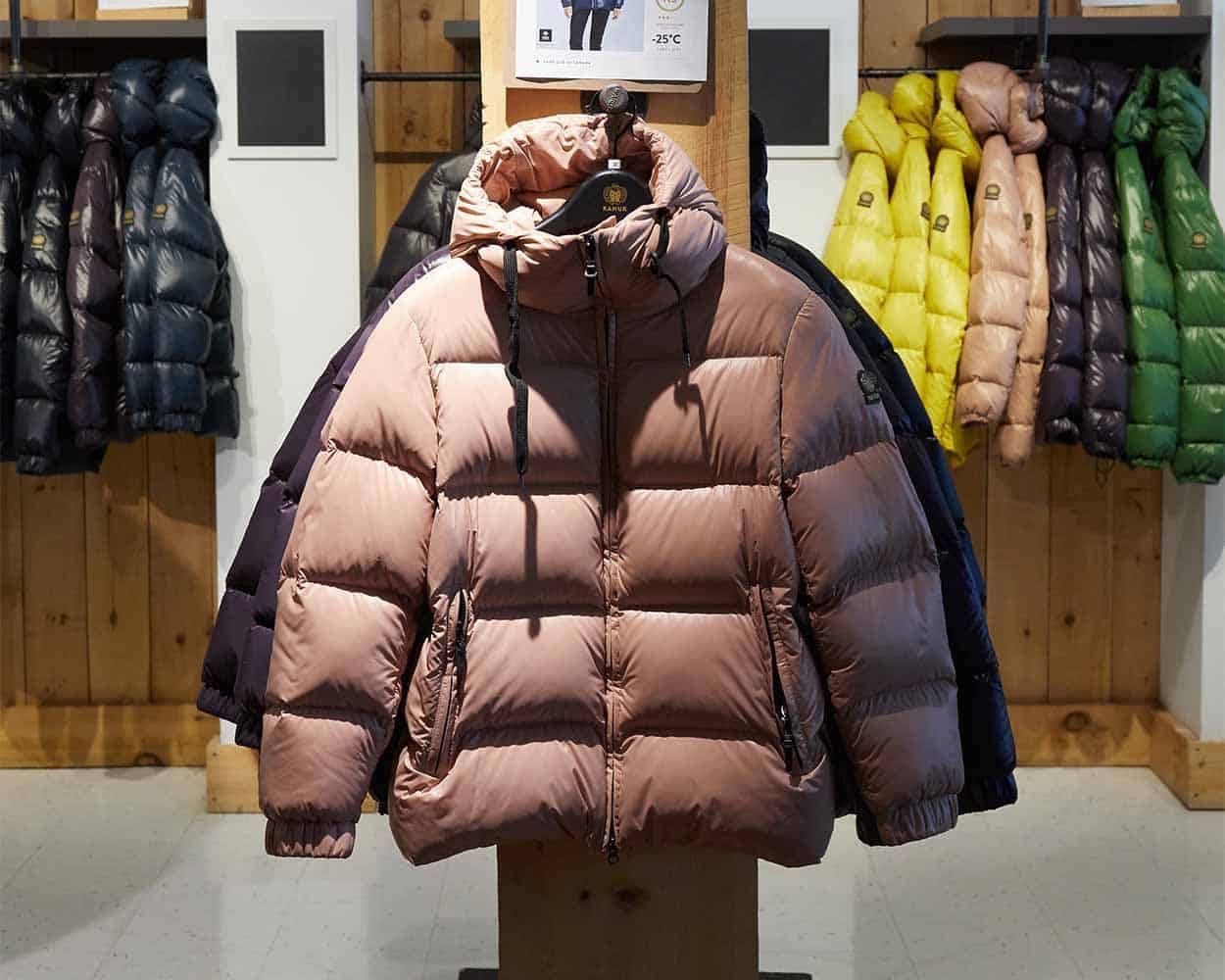
A gamble that paid off. The new models are seen everywhere on the streets of their hometown, sported by both baby boomers and Insta-fluencers. The details, the cut, the way the coats move, and the warmth—it’s easy to see why Kanuk is now an ‘in’ brand again. I can picture myself in one of their new parkas like the Blizzard, weaving my way slowly through the Old Port of Montreal. The mix of urban high-end and streetwear style has something for everyone.
Heritage + Modern = International Appeal
Now Kanuk looks to the international market. Still proud of being Montreal born, bred and based, they’re relative newcomers on both the national and international scenes.
“Canadian-made winter jackets are the thing right now in the winter-wear world,” says Michel. “Canadian know-how is sought after.” Leveraging this home-grown savvy is gaining ground with new markets, in particular European-based consumers.

As with most Heritage brands, Kanuk’s new clientele is a fan of their history, their originality, and their values. But it’s not just heritage that’s flipping the switch. It’s easier for younger clients like myself to identify with their style. I love the new Molly jacket with its sleeker puffy baffles and shiny shell. They aren’t just the bourgeois jackets my grandfather wore in the late 90s. They’re trendy, from the heart of one of the most fun and appealing cities in the world.

Their boutique is in one of the coolest parts of Montreal. Sara-Martine loves the advantages that the area lends. “There are also huge plusses that our manufacturing centre is right above our main boutique. We interact directly with our clients right away, finding out what works for them and what doesn’t.”
Tourists, rebels, business workers, influencers, baby-boomers… Kanuk has a little something for everyone.
A New I.D.
Or rather a newly defined I.D. Michel feels Kanuk has stayed true to what got them there. Despite the new styles and silhouettes, it’s still a Quebec-based apparel brand.
“With more outreach and more sales, it’s going to be a struggle to keep all our manufacturing here in Quebec. It already has an impact on price. But that’s also part of our appeal.”
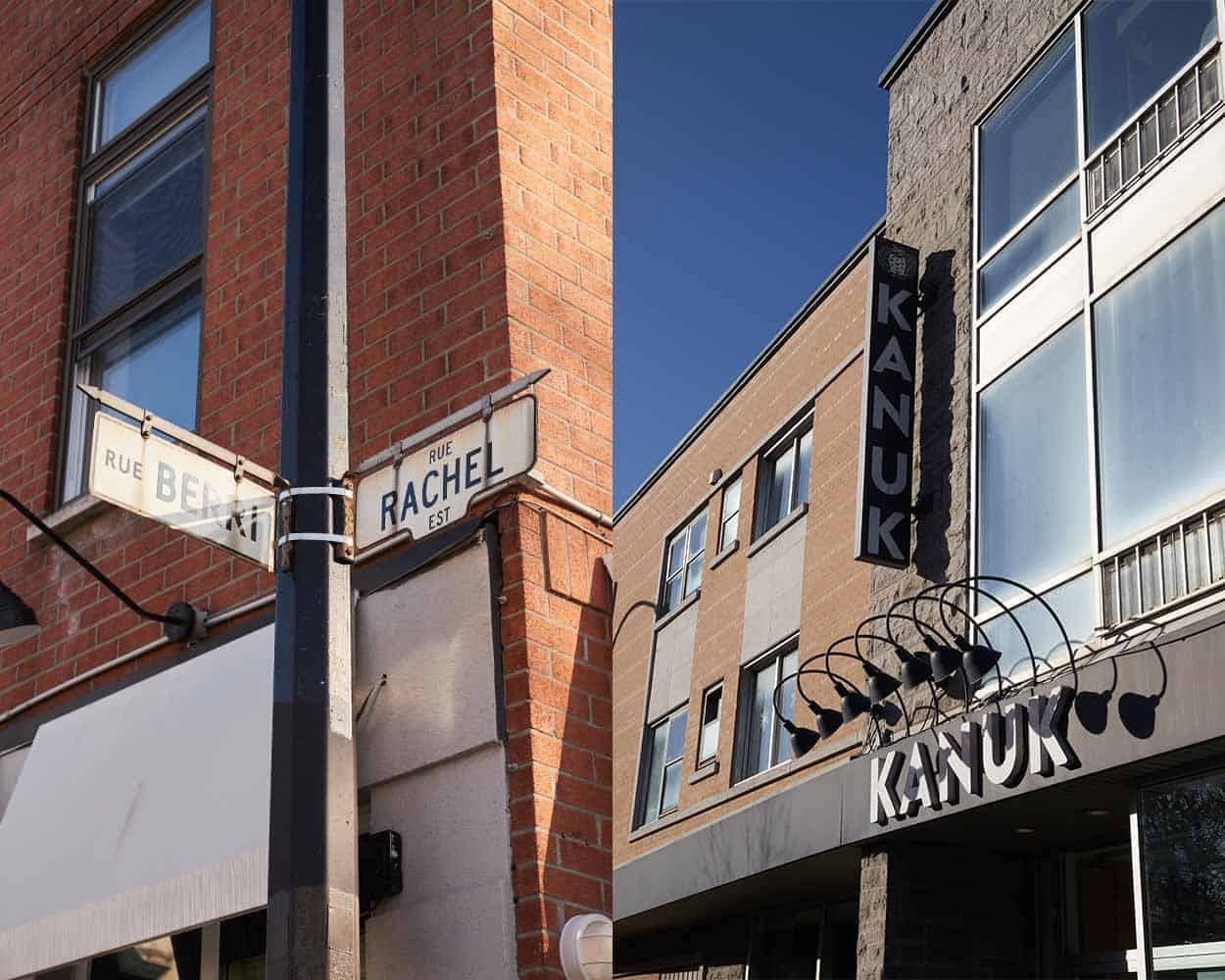
Their history is intertwined with Montreal’s. As is their future. Just visit their flagship boutique on rue Rachel. Light, warm, modern, you could linger all day. Try on a few jackets in the cold room to test just how warm everything is. And there’s the warehouse-style section, a touch of the past. Like the company itself, like the city—taking the best of the past and fusing it with the current to create the future.

Molly Women’s |

Mont-Royal Men’s |

Kiruna Women’s |
The post Kanuk—A Turn to the New appeared first on Altitude Blog.
]]>The post In The Mountains With Rab: Technical Clothing For Extreme Conditions appeared first on Altitude Blog.
]]>From state-of-the-art sleeping bags to coats and base layers for rock climbing, Rab specializes in trekking and mountaineering clothing and equipment. Inspired by the mountains and tested in extreme conditions, Rab is made to accompany you on all your outdoor adventures. And there’s no better way to enjoy the outdoors than with a multi-layer system.
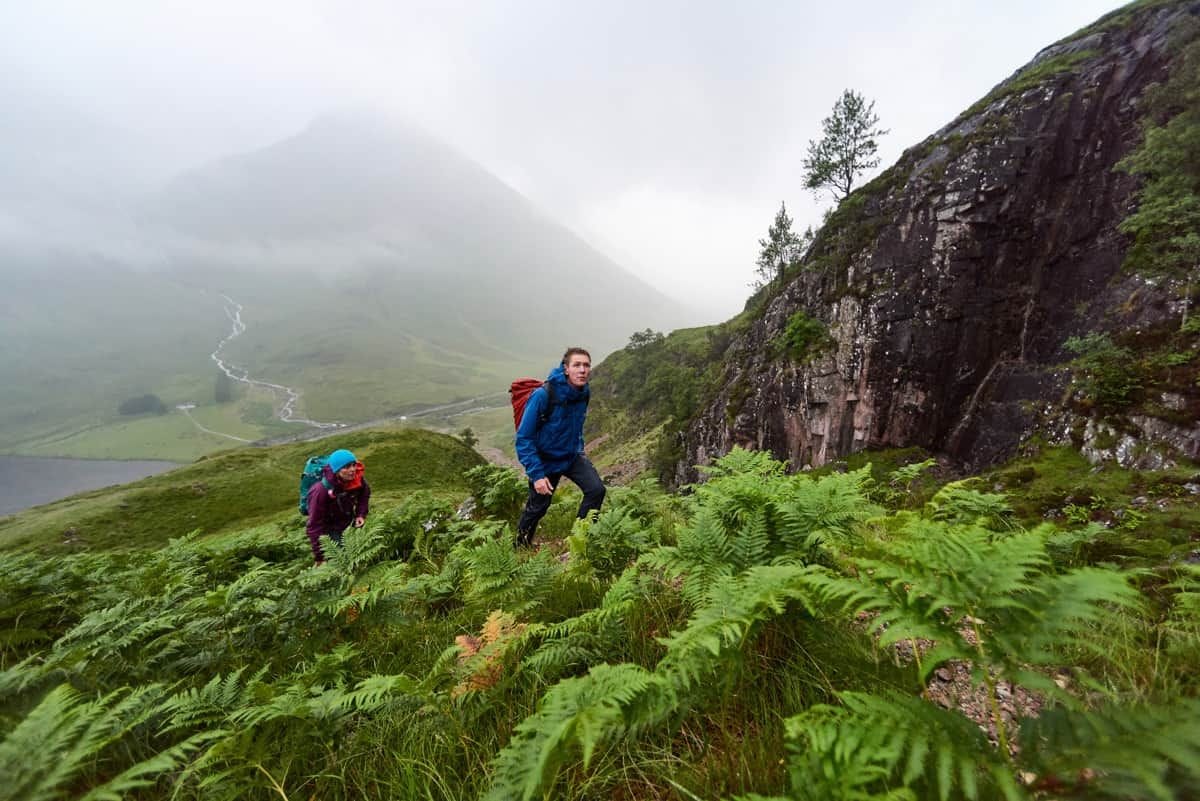
The Rab Multilayering System
Imagine yourself somewhere in Torres del Paine National Park in Chilean Patagonia. It’s a cool spring day in the mountains. You know that in ten minutes the wind will rise and the clouds will cover the sun. Now is the time for a multilayer system. Best to favour two or three thin layers over one large coat. This helps regulate body temperature and above all, repels humidity.
Rab is definitely not new to the world of outerwear. Their athletes have tested apparel from the frozen landscapes of Baffin Island to the steep ridges of southern Spain—and they’ve come out on top against the toughest challenges.
Now back to Patagonia. On a clear morning, a t-shirt is enough to get you through the first part of your trek. But the temperature can drop in an instant, and it’s times like these when you need to pull your midlayer out of your backpack. Pull on the Nucleus and stay comfortable thanks to its lightweight insulation. It breathes well at higher altitudes and versatile enough to wear to the café when you get back from Santiago.

Nucleus Pull-on Men |
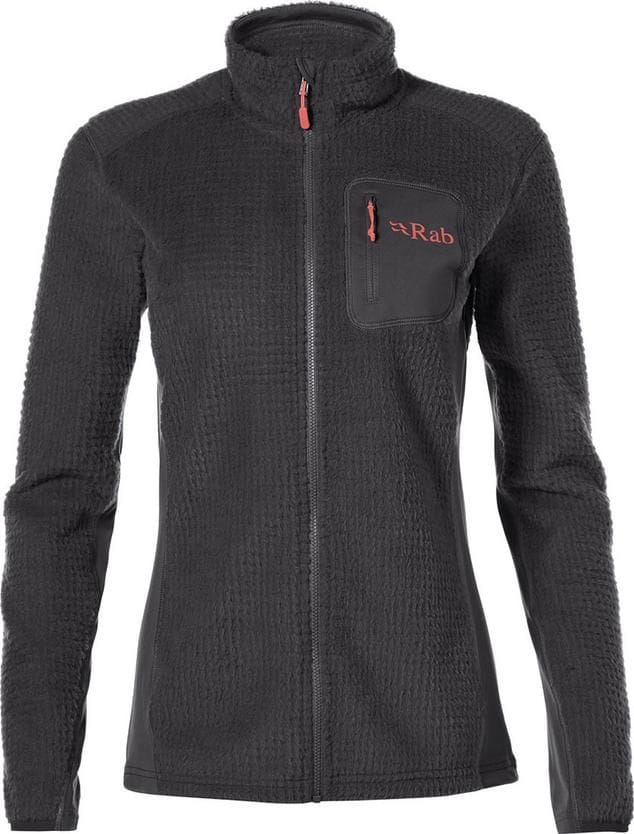
Alpha Flash Jacket Women |
Have a friend along on your South American adventure? Good thing you convinced them to bring their Alpha Flash jacket. This lightweight performance fleece offers an excellent warmth-to-weight ratio and packs away easily in any sized backpack.
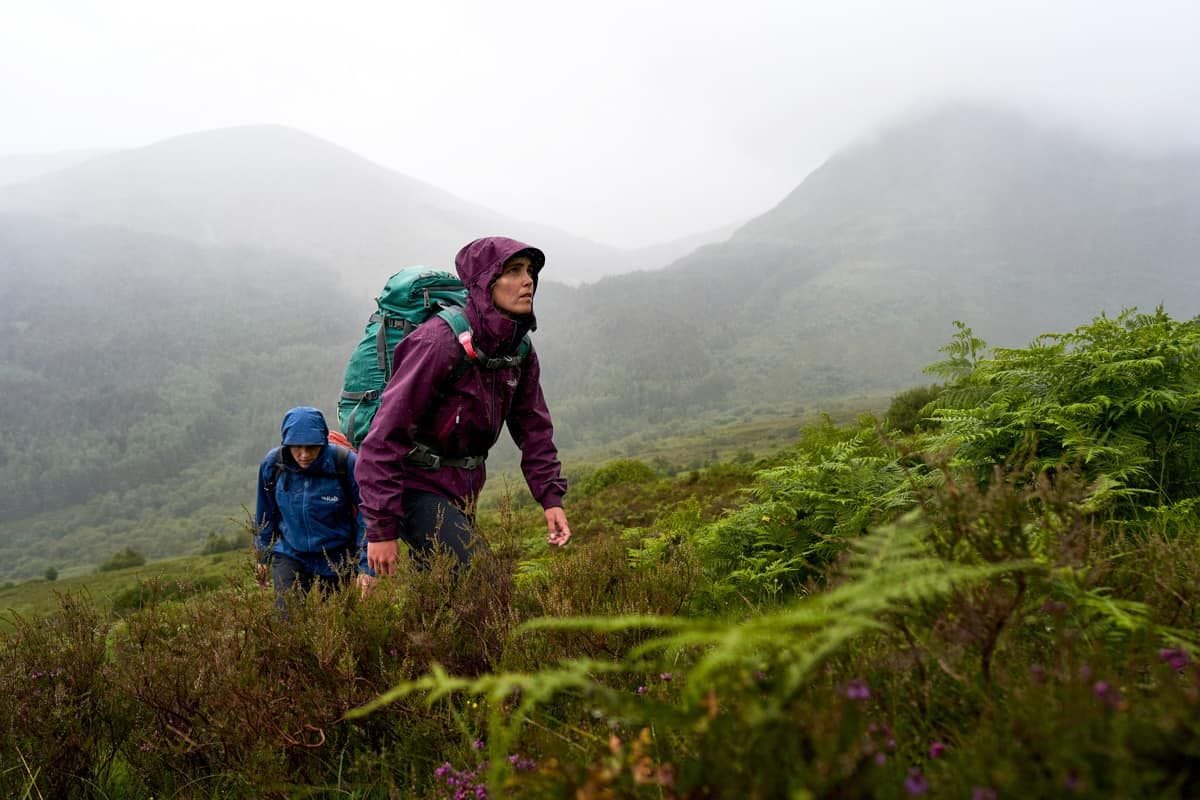
So Mother Nature is not on your side today as heavy rain starts to fall, and the spring sun disappears behind the clouds. For times like these, there’s no better choice than the unisex Downpour raincoat that slips easily over your midlayer. The Downpour coat is suitable for scattered showers. If showers turn to a torrential downpour, you’re better off going with a GORE-TEX shell like the Ladakh GTX Coat.
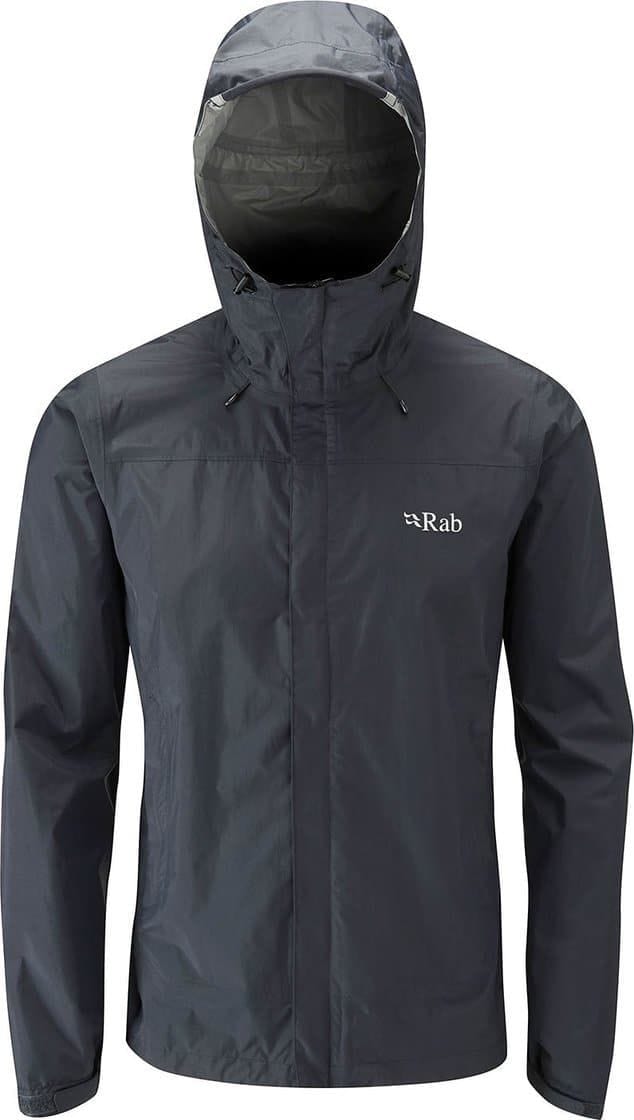
Downpour Waterproof Jacket Men |
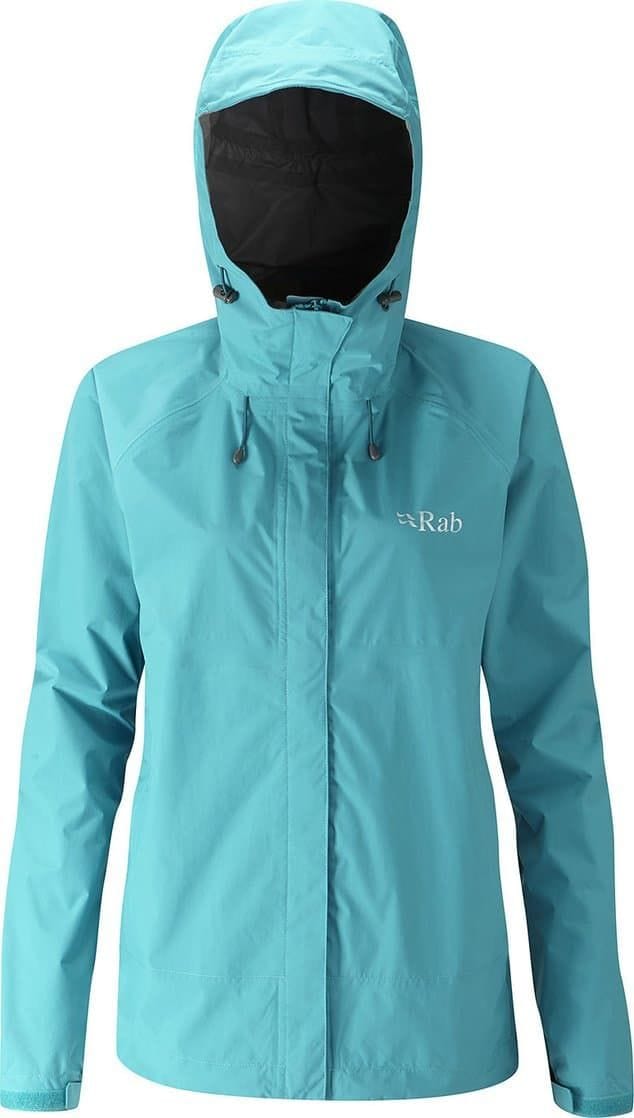
Downpour Waterproof Jacket Women |
Let’s leave the South American plains of Patagonia and venture over to the snow-covered peaks of the French Alps. Designed for high altitude expeditions where the winter cold can be unforgiving, the Positron Pro and Neutrino Pro coats are the perfect outer layers. Compatible with a helmet, ultra-warm and insulated with duck down, the Positron Pro coat is suitable for both winter sports and everyday life. The women’s Neutrino Pro coat is also designed for adventures in polar regions or at altitude, down-insulated, helmet-compatible and effectively repels cold and wintry gusts.

Positron Pro Jacket Men |
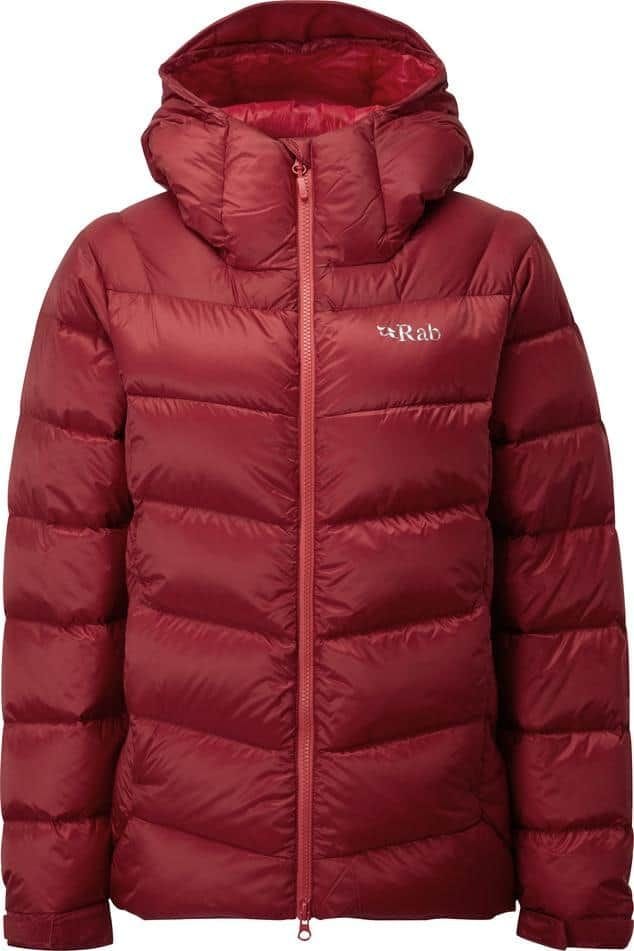
Neutrino Pro Jacket Women
|
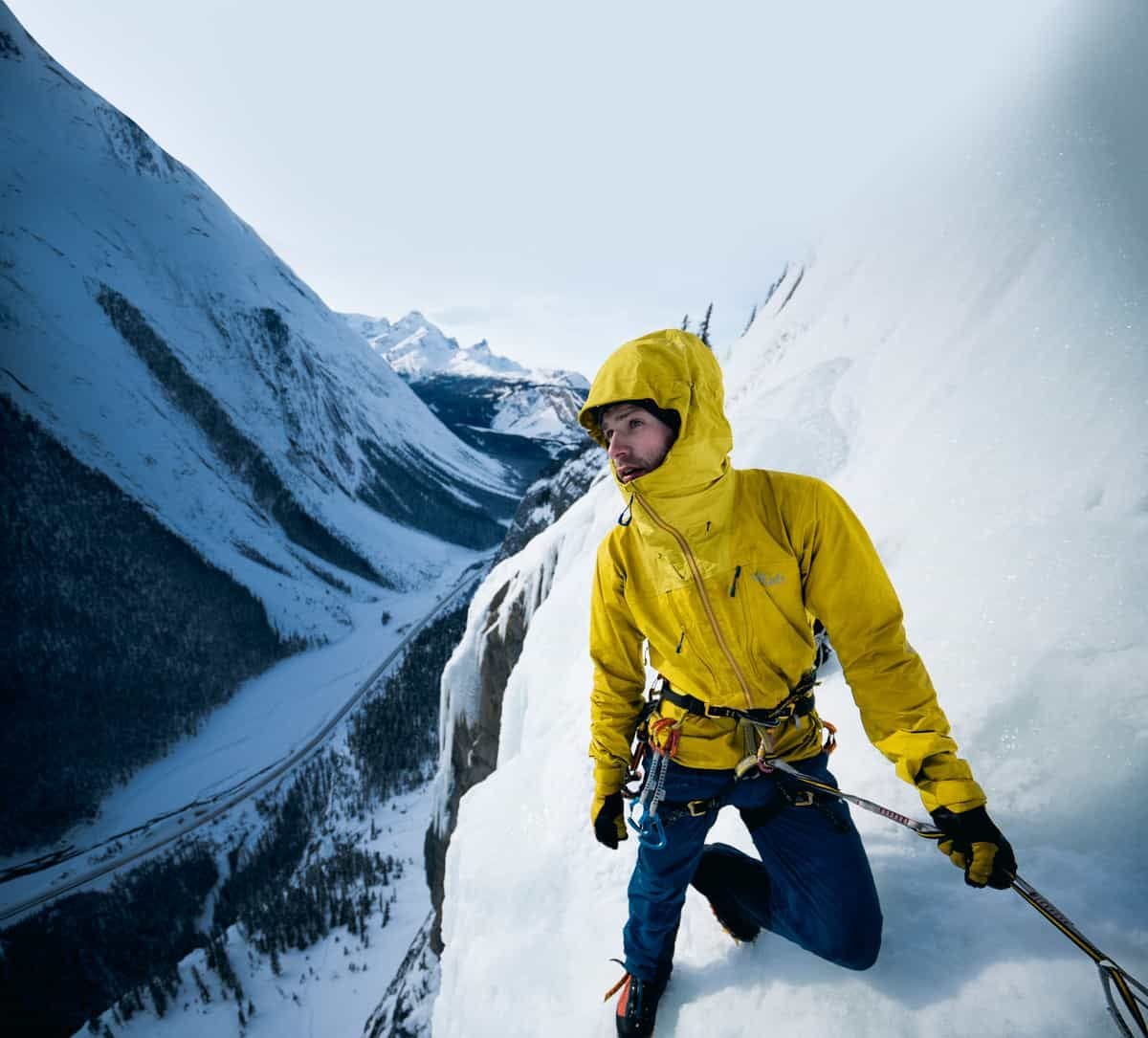
Rab is the ideal companion for every adventure, from the great white Canadian north to the rainy streets of London. With Rab’s collection of technical outerwear, you’ll be able to explore the four corners of the globe in total comfort. Discover Rab at Altitude Sports.
The post In The Mountains With Rab: Technical Clothing For Extreme Conditions appeared first on Altitude Blog.
]]>The post Forever an Olympian: Keeping The Sochi Halfpipe Dream Alive With Keltie Hansen appeared first on Altitude Blog.
]]>First Descents, First Competitions
However, we were not driving home, we were headed straight for Jasper National Park to go skiing. Ever since I can remember this is how my family spent our winter weekends. Every Friday my brother and I would get picked up from school and our family would drive 4 hours to reach the mountains. My friends at school often asked if I could hang out on the weekends. My reply was always the same “sorry I can’t, I’m going skiing with my family.”

My brother and I grew up skiing every bit of terrain that Jasper’s Marmot Basin Ski Resort had to offer. At an early age, my parents enrolled my brother in the Jasper Freeride program in an attempt to keep him busy. I quickly followed in his footsteps, joining the team when I was 7 years old, and that’s where it all started. The Jasper Freeride Team introduced me to the wild world of freestyle skiing.

I don’t really remember making a decision to join a sport where I launched myself into the air to perform tricks on skis. To be honest, I remember being really scared most of the time, but I loved the proud feeling of overcoming my fear. As I got older I began to compete more, entering Club Competitions, then Provincials, and Junior Nationals. I was usually on the podium, but there were so few girls competing in freestyle skiing at the time, it was difficult to gain a perspective on my abilities.
I competed in all the freestyle ski disciplines: moguls, big air, slopestyle and halfpipe. I liked them all, but moguls was the only Olympic sport, so there was pressure from the coaches to follow that path. However, my heart gravitated towards slopestyle, big air and halfpipe. So I continued to compete in all events finding national success in all of them. Fast forward a few years and I was 15 years old with several National Championship medals and a gold at the Canadian Winter Games under my belt. I was ready to start competing outside of Canada.
Victory in Colorado
In 2008, I went to my first event in the U.S. I travelled to Colorado to compete in my first-ever North American mogul event to test my skills against the U.S. competitors. There also happened to be an open entry professional halfpipe event just a few days before the mogul event. With encouragement from friends, I decided to enter the North American Open Halfpipe event just for fun.
To my absolute surprise, I won the event. I had been so focused on my own skiing I had barely watched the other women in the contest. Being a slightly naive 15-year-old, I actually left the contest without my prize money. I had no idea you could win prize money for that type of event. I stood on the podium in slight disbelief and then left happy with my backpack full of prizes. The next day I turned my focus to the mogul event where I ended up near the back of the field.

It wasn’t until a few weeks after I returned from my trip that my father received a call from the event organizers of the North American Open. They wanted to know how they could contact a Keltie Hansen because she had won $1000 dollars and never collected it. My dad said, “you must be mistaken, my daughter didn’t win the contest in Colorado.” He was thinking of the mogul event, the one they had originally sent me to compete in. Once he realized it was the halfpipe contest, it all made sense; he was also pleasantly surprised that his 15-year-old daughter had made $1000 in just one day while skiing halfpipe.
New Beginnings and a Taste of The Halfpipe Life
That event marked the beginning of my halfpipe career and the end of my mogul career. My parents told me they would support whichever direction I chose, so I carried the momentum of that first win and continued to learn new tricks and improve my skill on the halfpipe. At that time there was no Canadian National Halfpipe Skiing Team because it was not an Olympic sport.
The only option was to become a professional skier, seek out individual sponsors and pursue events like X Games, Dew Tour, and other open events like the North American Open. I began to travel with a provincial coach and a few other talented athletes from Alberta. Several years later, my best friend and teammate Megan Gunning, and I were invited to our first X Games! To say we were excited would be a huge understatement. We were two giggling girls who were just excited to be skiing together every day.

Megan Gunning shocked and awed the freeskiing world by placing second at the X Games with an extremely progressive run. I, unfortunately, had been skiing on broken bindings and was unable to finish my run, a hard, but well-learned lesson to always check my gear. I still remember having a huge smile on my face at the end of the competition. I mean my best friend had just made it onto the podium at the X Games!
After the event all the contestants that we idolized went out to party, but Megan and I being 17 years old, went out for dinner with our dads and coach to celebrate. After dinner, Megan and I curled up on the couch in sweat pants, watched a movie (probably Napoleon Dynamite) and recalled how crazy the day had been. Even at that time, I did not comprehend the full reality of where halfpipe skiing could take me. I had no idea that halfpipe skiing would take me all over the world and ultimately shape the next 10 years of my life. In the next few years, I started to wise up and began to realize my full potential as a skier.
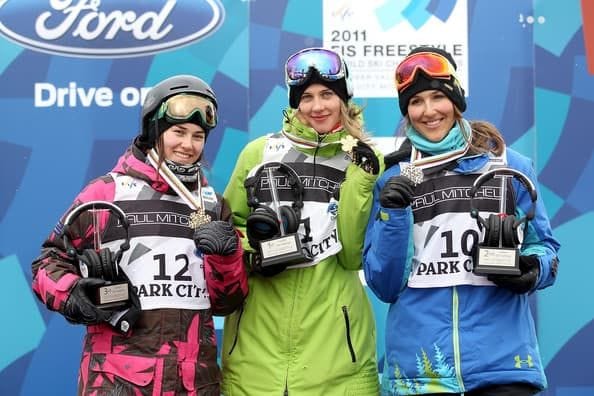
Setting Our Sites on The Olympic Games
In 2011, after a bronze medal at World Championships and a gold at the World (AFP) Freeski Professional Championships, the Olympic committee announced that halfpipe skiing would be included into the Olympics. The debut event would occur at the 2014 Winter Olympics in Sochi, Russia. Soon after the announcement, the first Canadian National Halfpipe Ski Team was formed. Megan and I were the youngest two females to be appointed to the women’s team to train alongside the talented and famous Sarah Burke, Rosalind Groenewoud and Dania Assaly. All of a sudden I had an Olympic dream and 3 years to prepare to earn my Olympic spot

The year before the Olympics, my chances looked great for one of those Olympic spots. I had finished top five at every World Cup and won the bronze medal at the Olympic Test Event in Sochi, Russia. Now I was not only a shoo-in for an Olympic spot, but I was also a contender to win a medal for Canada.
Motivated by my successful season I worked harder in training and was committed to learning new tricks for the season ahead. Sadly, all my momentum came to a screeching halt when I crashed and injured my knee at a summer training camp before the Olympic season. Turns out I had torn the ACL ligament in my knee.
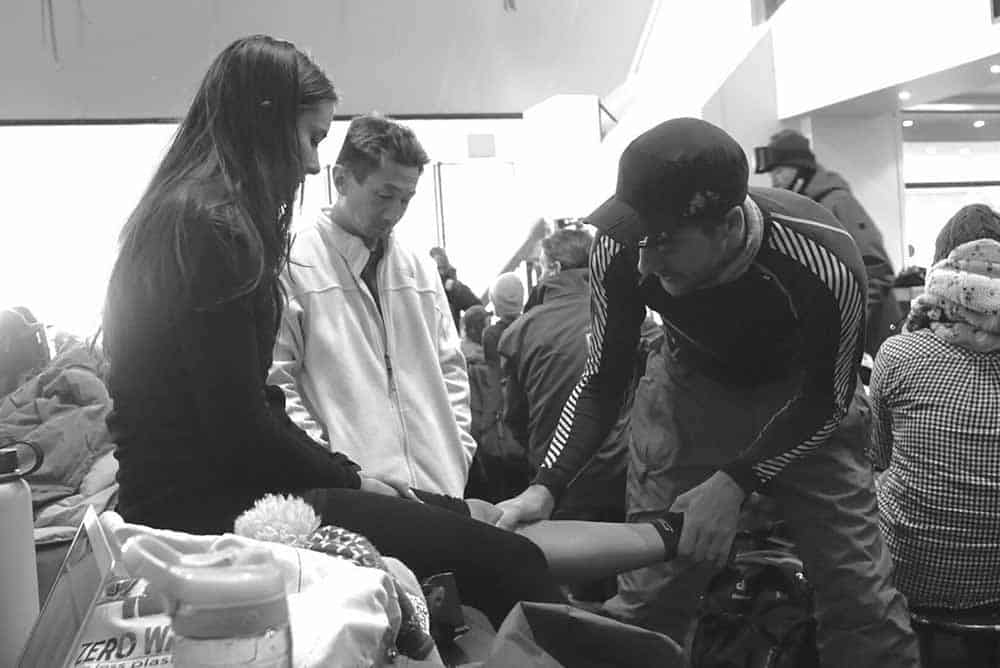
Setback and Keeping the Olympic Dream Alive
Usually, when an athlete tears an ACL it takes a year before they are fully competitive again. I remember sitting in a hospital bed when the doctor explained my situation. I was staring at my knees—they still looked fine, the right knee was just a little swollen. The doctor told me I would need surgery and it would take about a year to heal.
As the reality of those words sunk in, my chest tightened and I felt light-headed. My Olympic dream was gone, just like that, and after all my hard work. Out of my daze, I heard my mothers voice, “she is so close to qualifying for the Olympics, is there anything you can do?” The Olympics were in 8 months, and I needed to be back training and competing within 6 months.
My doctor explained that we could fast track my recovery if I was willing to work extremely hard. He would allow this because I had no other damage except to my ACL ligament. My knee would not yet be fully healed when I returned to snow, so I would have to ski in constant pain. If I could withstand this, the doctor was confident my knee would be fine if I trained smart and didn’t try anything too risky.

My injury changed my Olympic dream, I no longer had a medal in my sights, I simply wanted to go. The months leading up to the Olympics were some of the most difficult I have ever experienced. As my family and friends witnessed, I was determined and extremely stubborn—I had been given a second chance and I was going to make it happen.
Against All Odds and A Spot on the Sochi 2014 Canadian Halfpipe Team
I focused all my energy on healing and preparing mentally and physically for my early return to the snow. I went to the gym almost 7 days a week and in my free time, I visualized my skiing. Finally, with the help of my doctor, family, and the support staff at Canada Freestyle, I competed 6 months post-operation and I earned my Olympic spot. Two months later I competed as one of the first ever-female halfpipe skiers at the 2014 Winter Olympics!

I finished 13th at the 2014 Winter Olympics, one spot outside the final. At the time this result broke my heart. The previous season I had been aiming for the podium and now I was not even in the final. The reality was that I had successfully returned to competition to earn my Olympic spot, but I was not skiing at my full potential. At the time it was hard to let go of my previous standard of success. For several months after the Olympics, I struggled with mixed emotions about my experience. I felt pride at having overcome my injury and becoming one of the first halfpipe skiers to compete at the Winter Olympics. But there were also feelings of deep disappointment and I was haunted by the thought “what if I had been fully healthy?”
Once An Olympian, Always An Olympian
It took me several years to gain perspective on my own Olympic experience. Today when I reflect on my Olympic journey, I think of it as a success and appreciate the hard work I put into my rehabilitation. I know that I made the best of my situation and because of that I will forever be an Olympic athlete. I now smile at the thought of what that little girl in the minivan would have thought if you had told her she was going to become an Olympian!
The post Forever an Olympian: Keeping The Sochi Halfpipe Dream Alive With Keltie Hansen appeared first on Altitude Blog.
]]>The post Helly Hansen is Ski Gear of the Pros: Outerwear Testing on Opening Day Powder at Fernie appeared first on Altitude Blog.
]]>

















